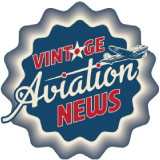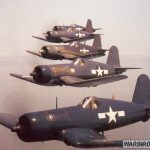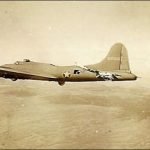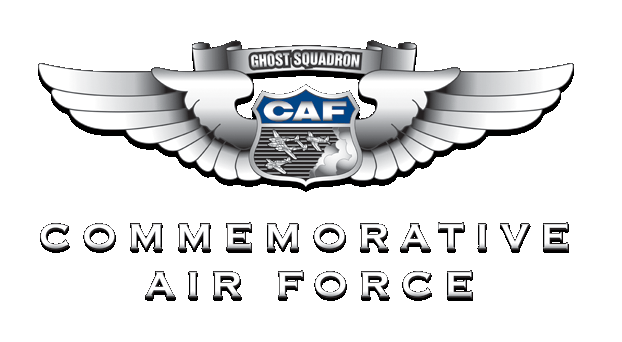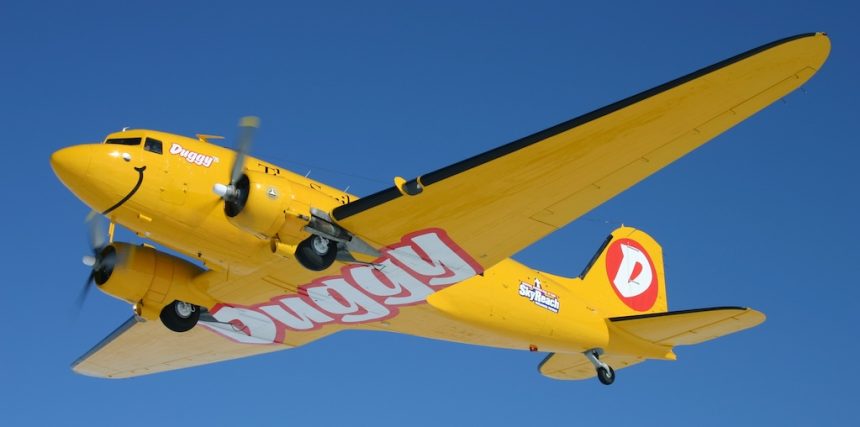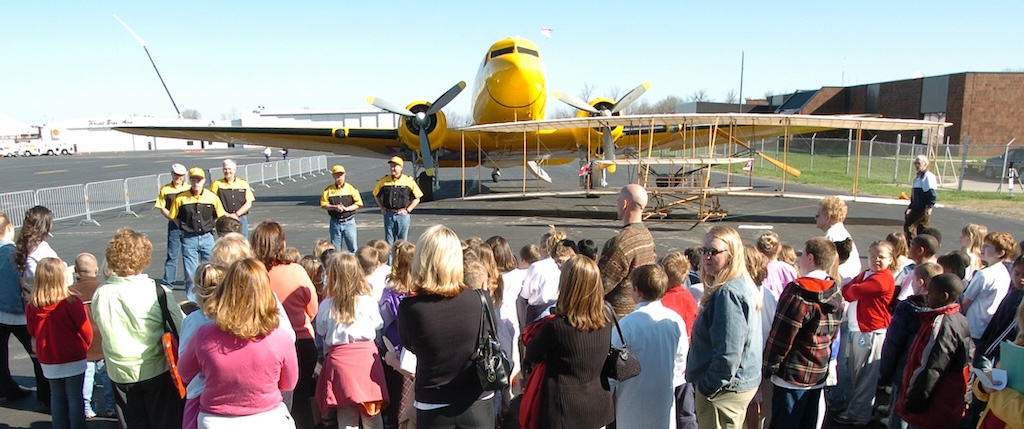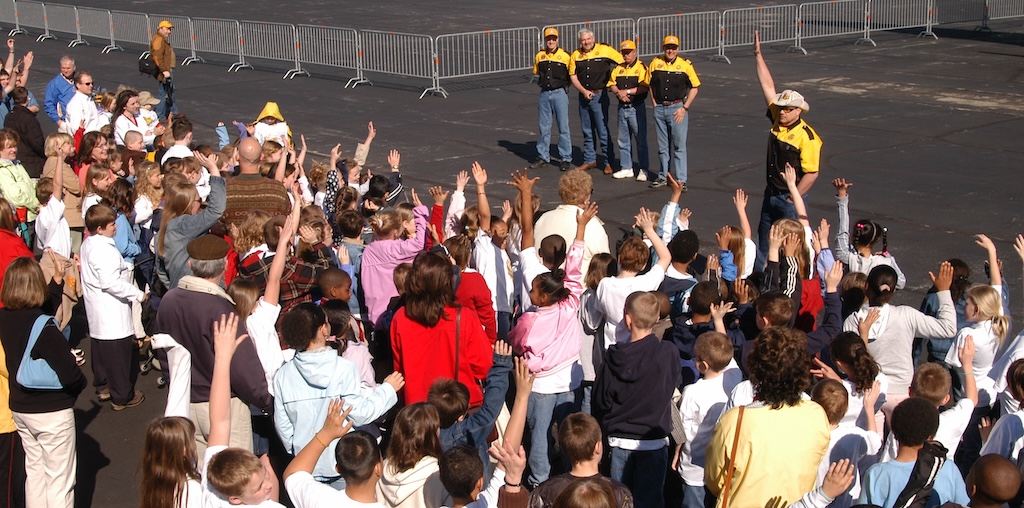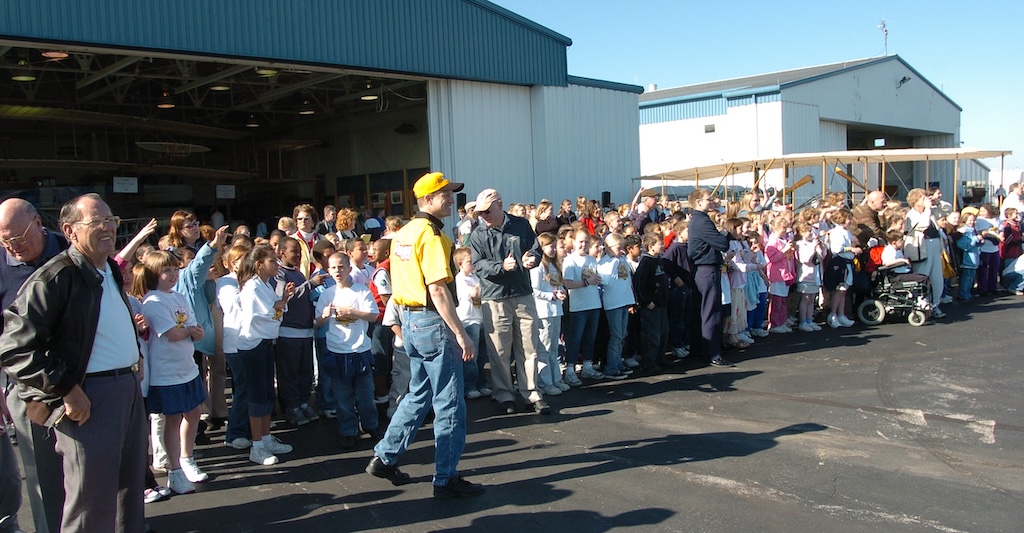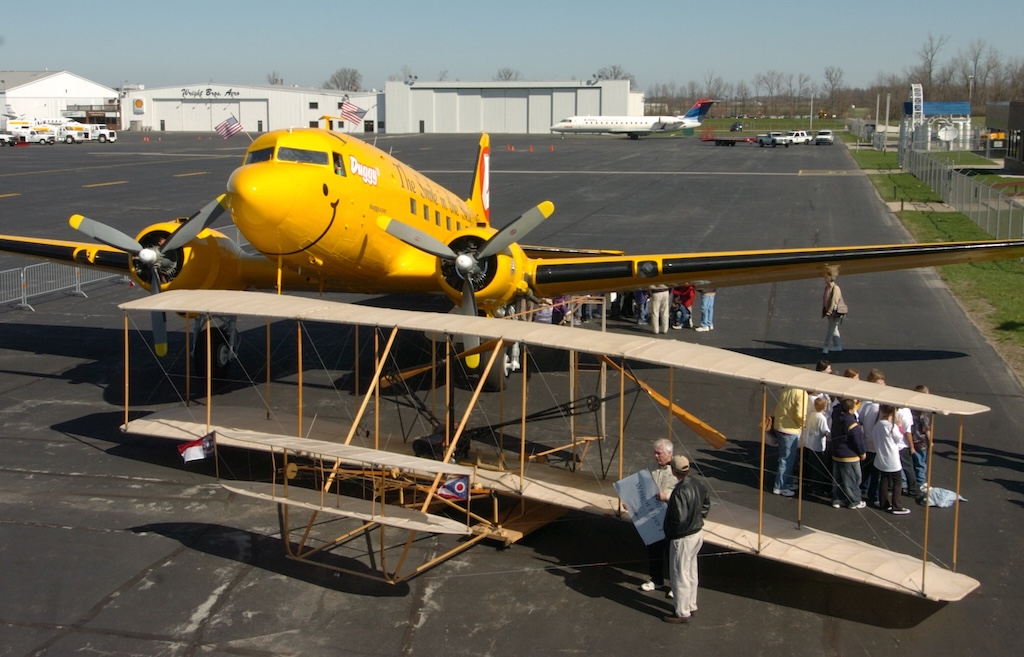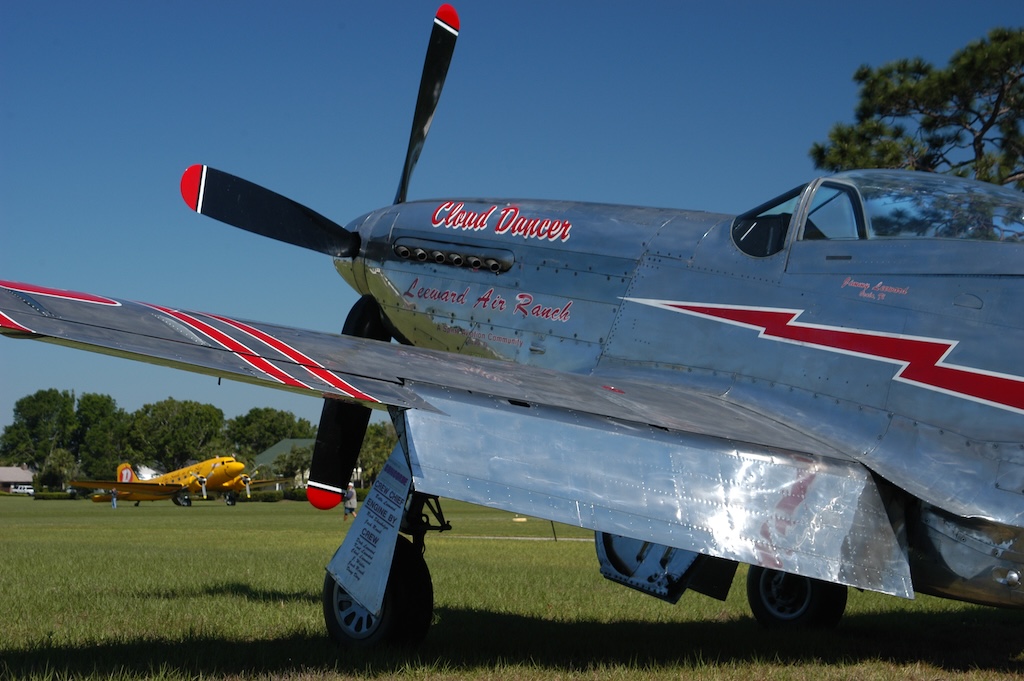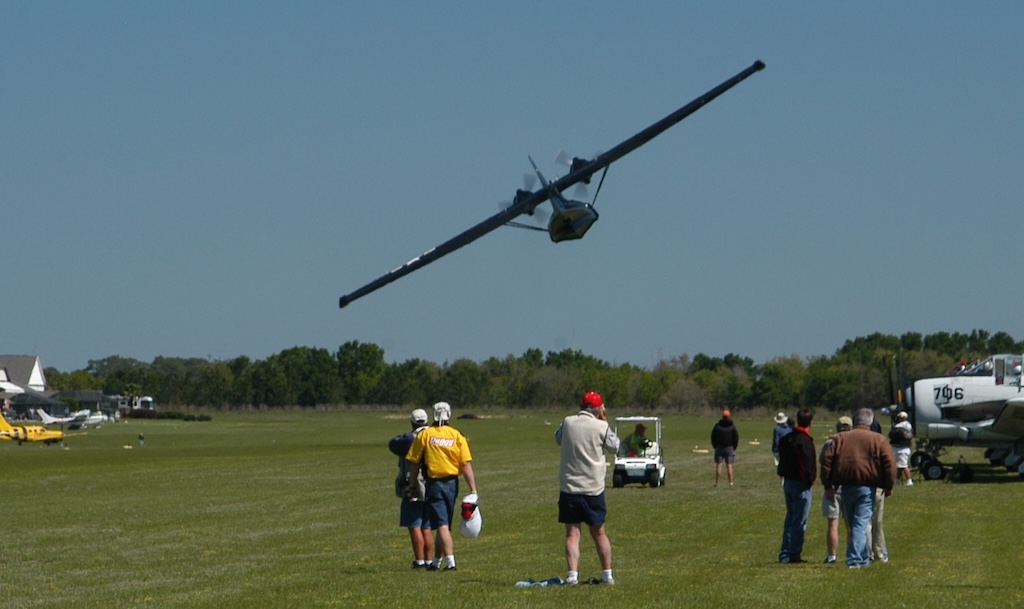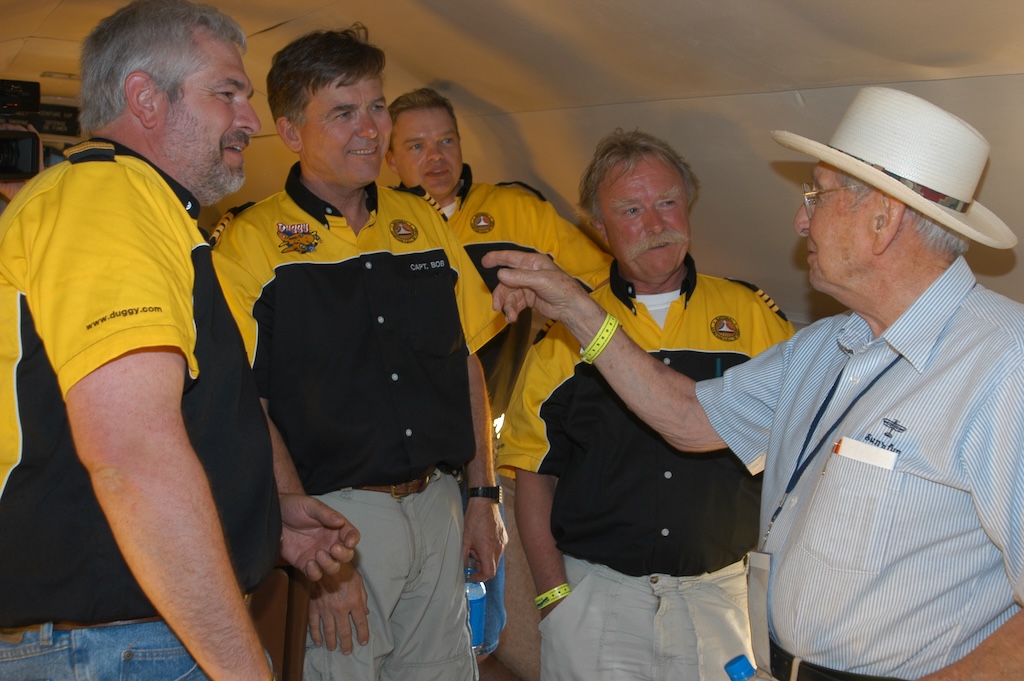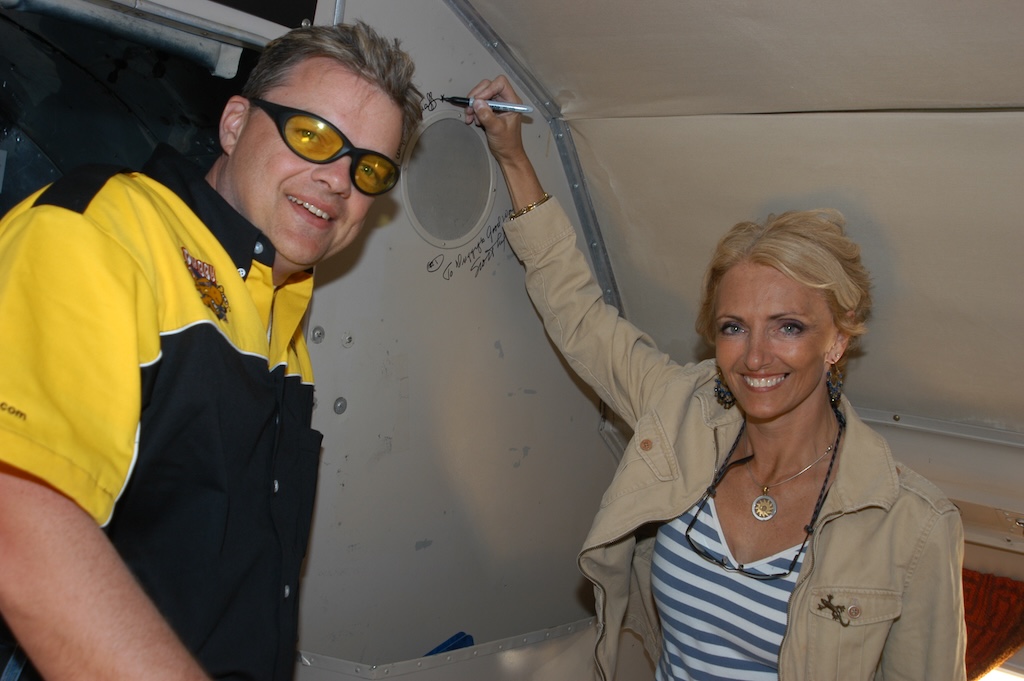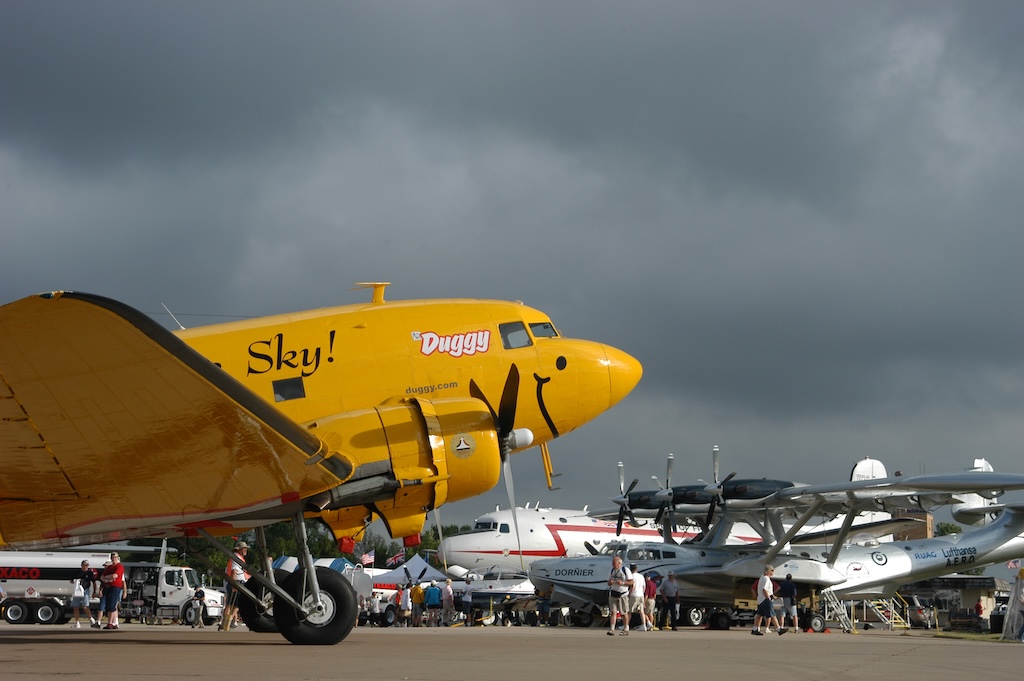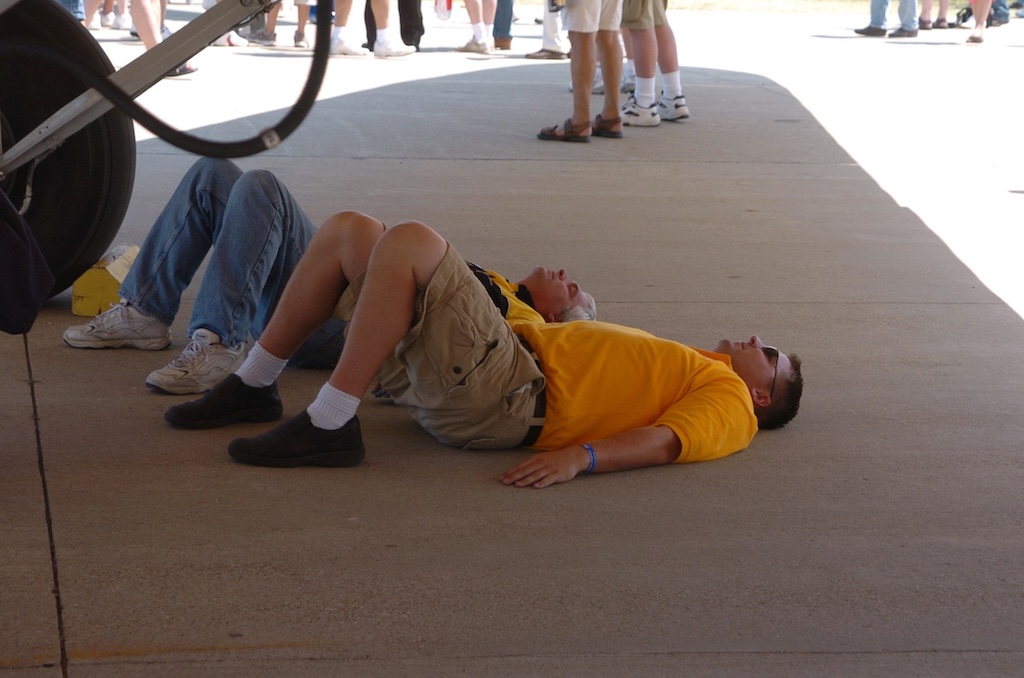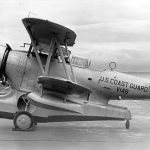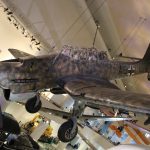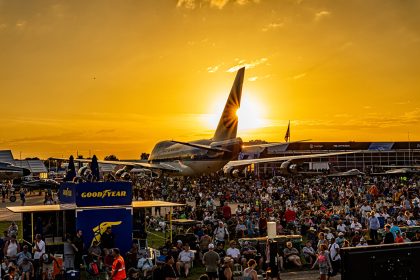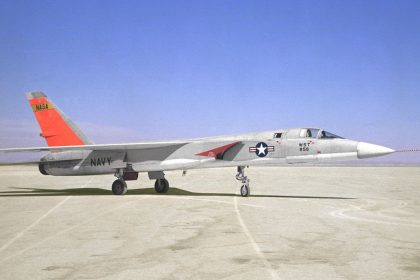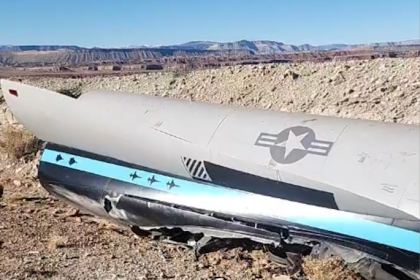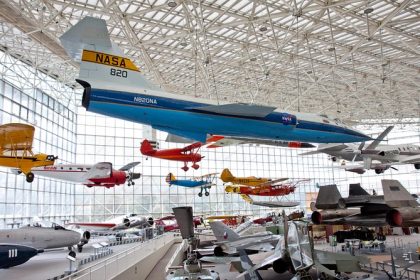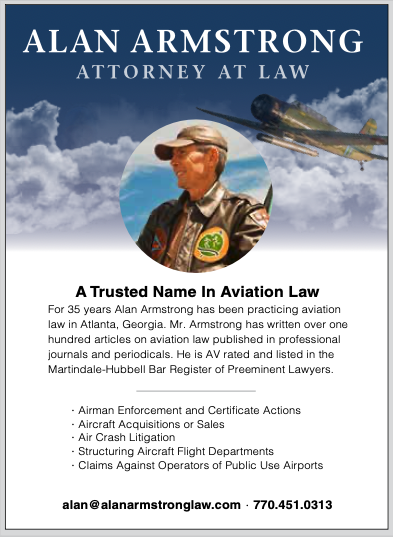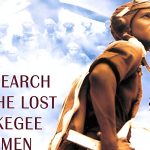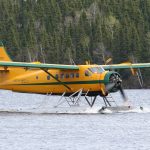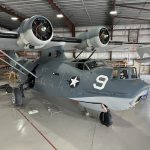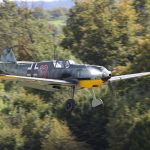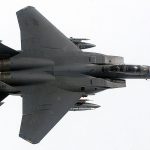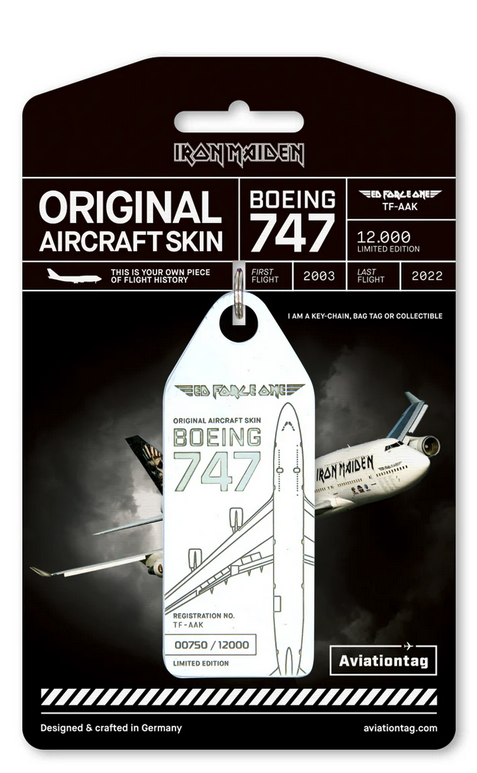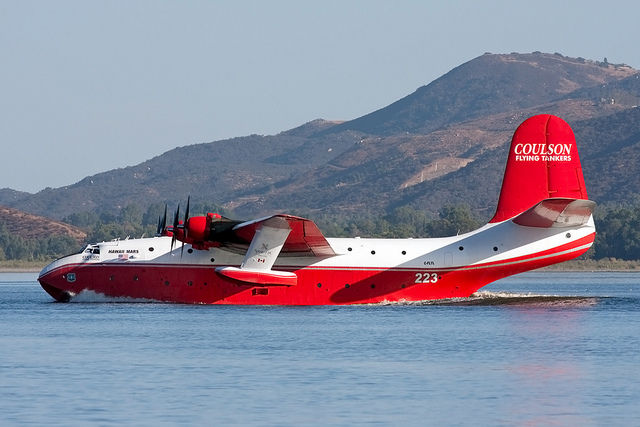By Ed O’Bradovich
It was twenty years ago this month that one of the most uniquely spectacular aviation education programs officially took flight, even if but for one glorious year. In April of 2005, the debut of “Duggy the DC-3” for the non-profit “SkyReach” youth education program of the National Aviation Hall of Fame (NAHF) took place in Lakeland, Florida at the annual Sun-N-Fun fly-in, much to the delight of young and old alike and spawning the international attention of the media.
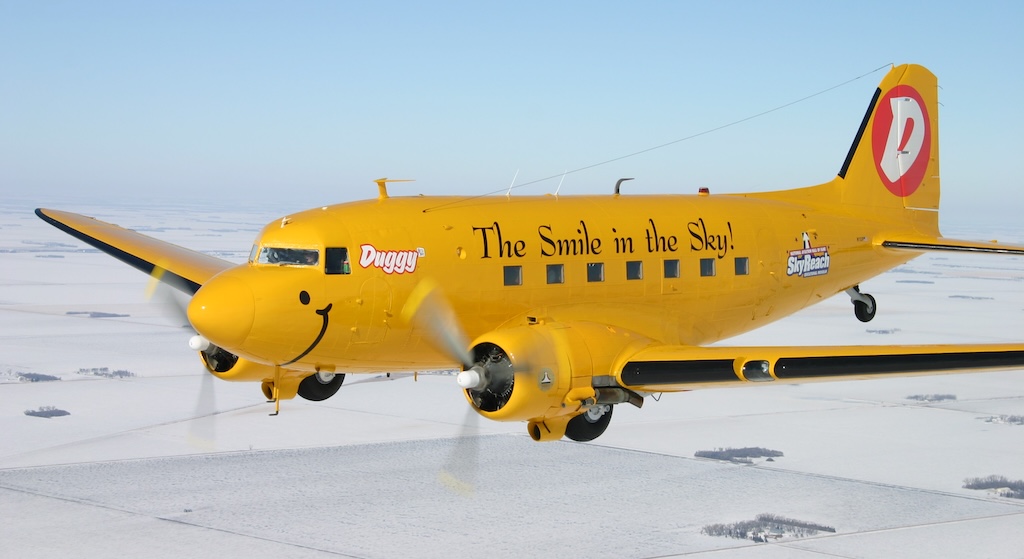
The brainchild of creator Mitch Carley, “Duggy”, named for DC-3 creator Donald Douglas, began as one of several animated iconic aircraft characters he developed as a youngster, inspired in part by his father, a former Air Force mechanic working at North American Aviation in Columbus, Ohio. Carley’s cartoon DC-3, which he dubbed “The Smile in the Sky,” sported a bright yellow paint scheme to rival any Piper Cub and, uniquely, a big smile on its “face.” Later, as a father, Carley truly recognized Duggy’s potential value as a way to entertain kids while teaching them about the history of flight. In late 2003, Ron Kaplan (1a) , then Deputy Director of the Dayton, Ohio-based National Aviation Hall of Fame, had a burgeoning character education program for elementary age school children that highlighted the Hall’s enshrinees, a who’s who of nearly 200 American air and space pioneers. With everyone else in the aviation community using STEM as their education focus, Kaplan saw the value in SkyReach to augment STEM, its character development focus as an opportunity to showcase individual NAHF enshrinees as the people side of what could otherwise be a dry subject to many youngsters.
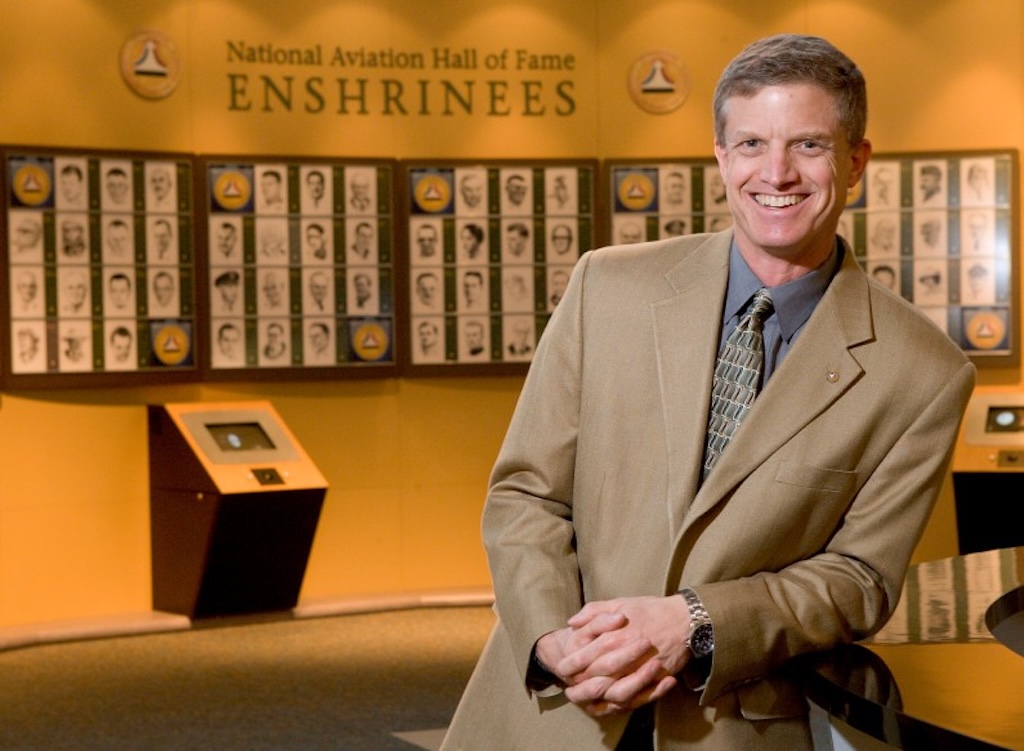
After Kaplan came away highly impressed from a meeting with syndicated radio show host and character education advocate, Michael Josephson, the NAHF signed an MOU with the Josephson Institute of Ethics. The Institute’s “Six Pillars of Character” (Trustworthiness, Respect, Responsibility, Fairness, Caring, and Citizenship) provided numerous ways to highlight enshrinees of all backgrounds. But Kaplan and his staff understood the challenge facing any education program – how can you attract and engage the young people? Fortuitously for both, Carley, then working in Texas in corporate marketing, came across an article announcing the NAHF’s new SkyReach program. He reached out to Kaplan, with whom he had crossed paths many years before when both worked in media and advertising in their hometown of Columbus. The pair found they had much in common. Like Carley, Kaplan’s father had an aviation background, having been a B-25 pilot-instructor in WWII and a private pilot as Kaplan was growing up. And both Carley and Kaplan laughed at finding that each, as grade schoolers, had been admonished for drawing airplane pictures instead of paying attention to their teacher (Carley drew DC-3s and Kaplan drew the SPAD of Eddie Rickenbacker, another Columbus native). Upon seeing Carley’s pitch for “Duggy and Friends,” Kaplan was confident the NAHF had found his “hook” for Skyreach. Supported largely by a federal grant, the NAHF licensed “Duggy and Friends” for SkyReach use, and Kaplan contracted Carley as a consultant. Almost immediately, Carley was in Dayton, working alongside NAHF staff to integrate his cartoon characters with the SkyReach curricula already under development. Carley and Kaplan, with their shared marketing experiences, recognized that Duggy’s potential was enormous. Carley had deftly created not just a cartoon but a brand. Promptly, a line of “Duggy and Friends” t-shirts, stickers, posters, and other popular items promoting SkyReach and the NAHF were developed. Several years prior, Kaplan had orchestrated a deal with Mattel’s Matchbox division to produce scale NAHF-branded die-cast aircraft models of select enshrinees, so naturally, thought was given as to how “Duggy and Friends” might similarly be produced as a toy line, generating revenue while expanding the reach of SkyReach. Carley, who had previously produced air show content for cable TV, worked on storyboards for a potential animated broadcast series.
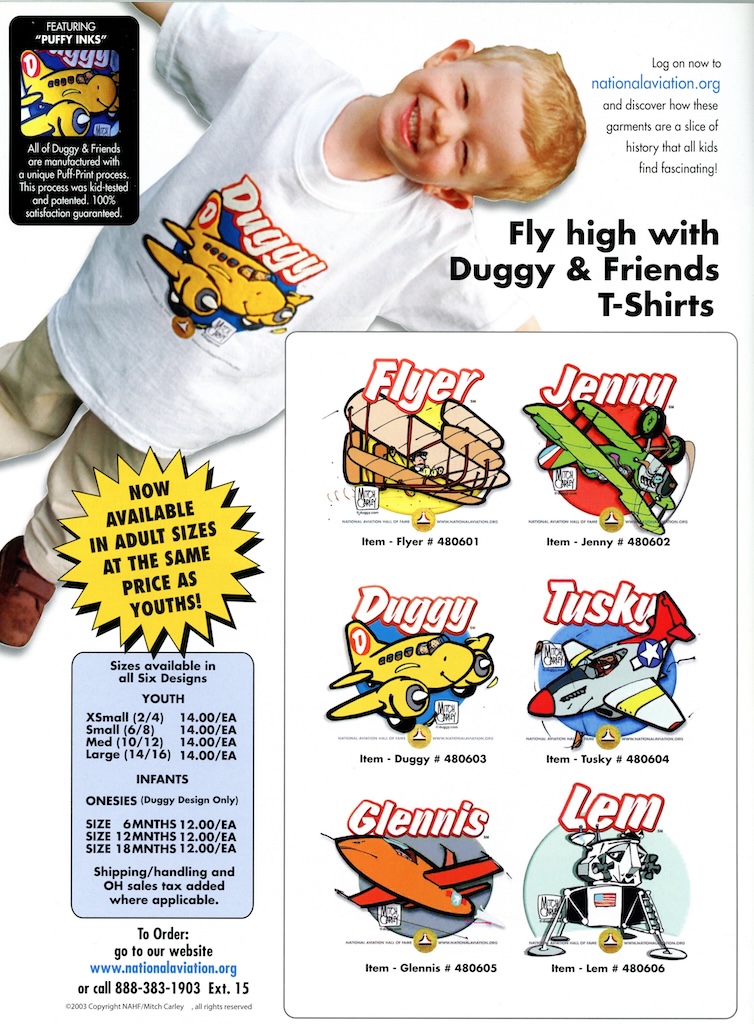
Within months, they launched the SkyReach Youth Education program, with “Stang” (North American P-51), “LEM” (Lunar Excursion Module), “Kitty” (1903 Wright Flyer), “Glennis” (Bell X-1), and “ Jenny” (Curtiss JN-4) characters joining Duggy. The six were first featured in a booklet created to lead visiting schoolchildren through the enshrinee exhibits and interactive displays of the NAHF Learning Center, co-located at the National Museum of the United States Air Force. Carley had the honor of leading the first group of local fifth graders to tour the Learning Center using the new Duggy & Friends booklet, and the kids also each got to select a complimentary t-shirt from the new line. Like the Pied Piper, Carley led them through the era-themed hall and sketched each student a cartoon airplane of their own to keep. The NAHF’s volunteer docent corps was instructed on how to implement the new booklets in the Learning Center. Kaplan, delighted with the positive feedback SkyReach began receiving from the kids, teachers, and volunteers, soon dubbed Carley “the Walt Disney of aviation.”
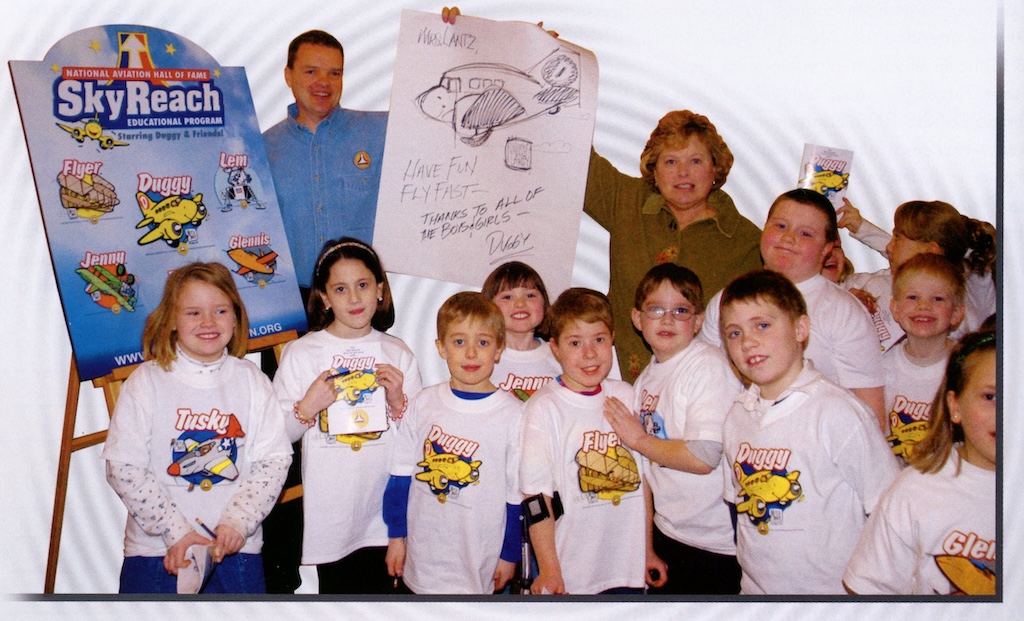
All the while, Carley shared with Kaplan his grand vision, dating back to his earliest creation of Duggy, of one day having a real, flying Duggy the DC-3, the bright yellow guy traveling the air show circuit as “The Smile in the Sky.” Such a spectacular flying classroom concept could take SkyReach and the NAHF’s “Learn from the past, dream for the future” message almost anywhere and connect with far more than a few thousand schoolchildren. The more the two men thought about it, the more they thought, why not? Thus, in late 2004, Kaplan and Carley, along with commercial big jet pilot, Rob Challans, a partner of Carley’s, commenced their search for a DC-3 that the NAHF could lease and Carley could transform into a real-life, flying “Duggy,” complete with interior seating and SkyReach displays. Despite the all-hands-on-deck effort, after a month of calls and visits, they were coming up empty. A former chicken hauling C-47 in Iowa was unworkable. Several former auto parts haulers parked in Ohio could not be purchased and were stuck in receivership. Restored DC-3s were too expensive, too sacred to convert, or simply not available. While in California for a toy manufacturer visit, the trio sat down to consider giving up the prospect of ever having a real Duggy, their options of finding a suitable DC-3 seemingly exhausted. Kaplan, who prided himself on being able to “connect the dots,” realized he just might have a couple of more left to connect. The upcoming National Aviation Heritage Invitational, which he co-founded at the Reno Air Races, was coming up in a few weeks.
Widely known as “The Invitational,” and then sponsored by Rolls-Royce North America, the juried competition recognized excellence in the restoration of vintage aircraft to flying condition. It attracted the owner/operators of some of the best airworthy classics in the world, their flying museum pieces on static display throughout race week. On Sunday morning of race weekend, before the final heats, the winners of the different Invitational categories and the Grand Champion received their trophies, the presenters including attending NAHF enshrinees like Neil Armstrong, Bob Hoover, Bud Anderson, and others. They also presented the NAHF “People’s Choice Award” trophy to the owner of the restoration, who was voted as the favorite of spectators who had come through the two dozen or so competing aircraft in the days prior.
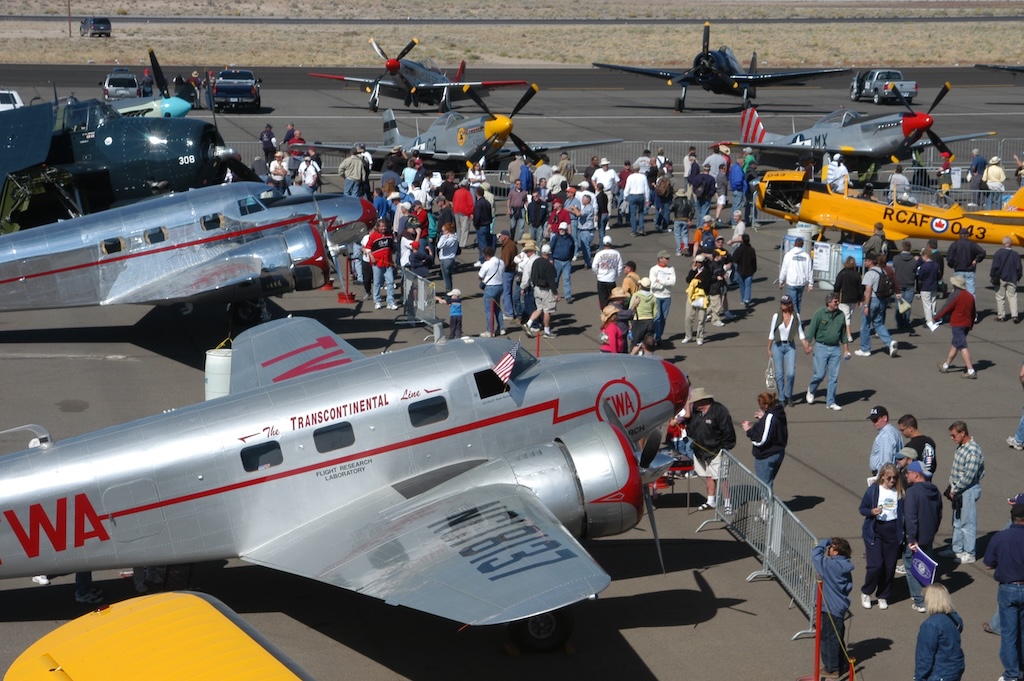
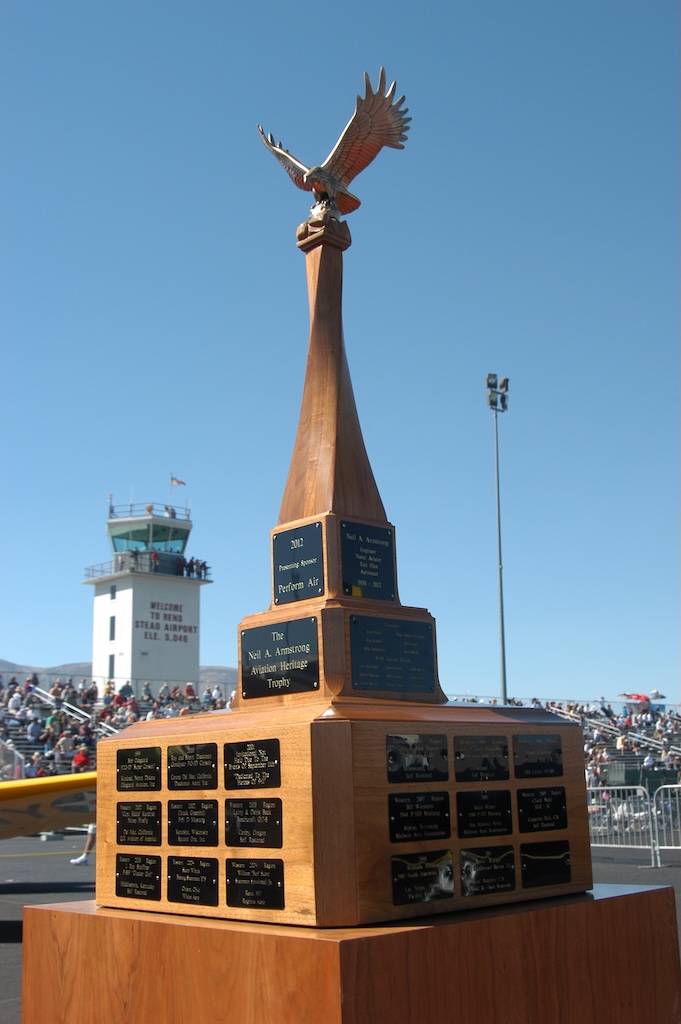
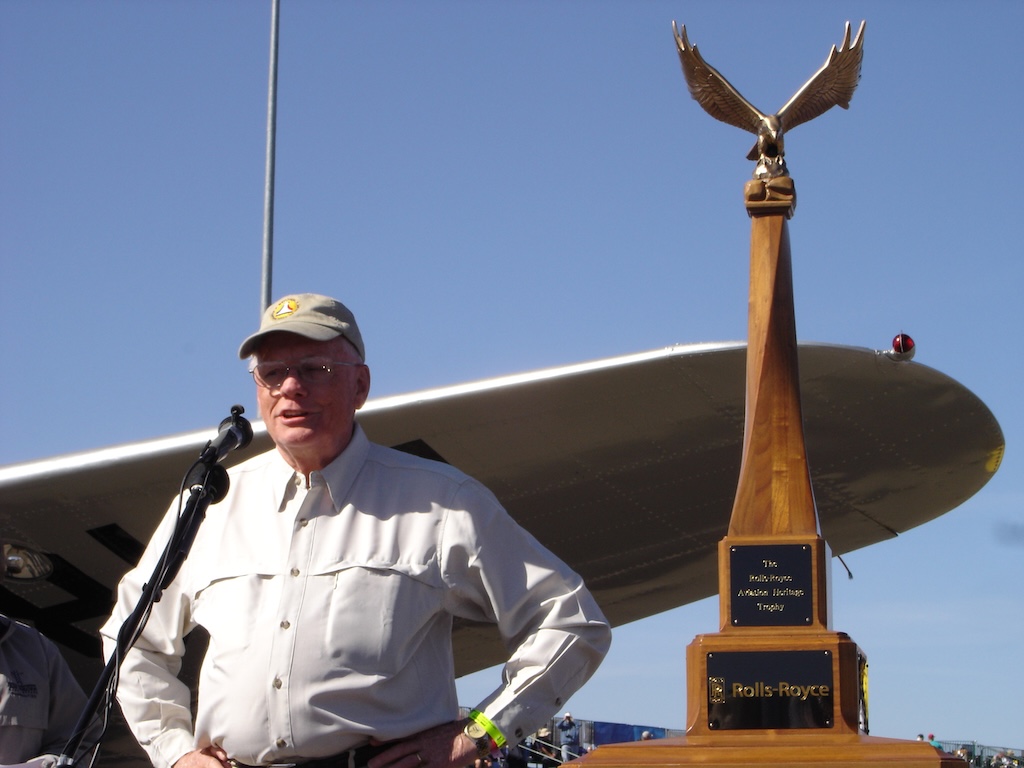
One of the Invitational’s perennial participants was warbird restoration expert and air show pilot, Bob Odegaard, of Fargo, North Dakota. At the inaugural Invitational in 1999, it was Odegaard’s eye-watering restoration of Cook Cleland’s former race-winning F2G-1 Super Corsair, the bright orange “Race #57,” that easily won both the Grand Champion trophy and the NAHF People’s Choice Award.
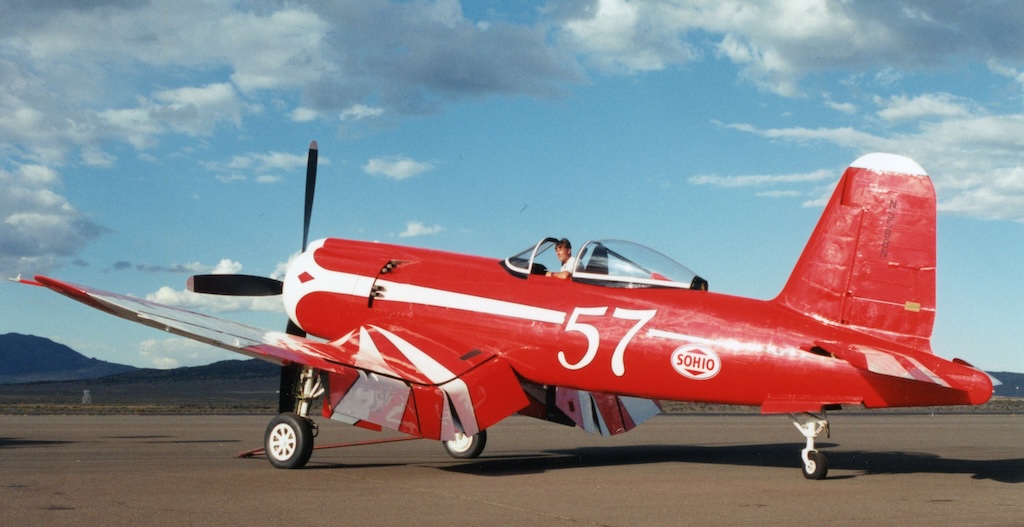
“Odie,” as he was known, and his family were highly respected warbird restorers and operators. Kaplan recalled Odegaard telling him of not one but two DC-3/D-47s that he kept among a gaggle of airworthy warbirds based out of his Fargo Air Museum. He had seen one of them when Odie brought it to Reno a few years earlier, and believed Odie might just entertain leasing one to the NAHF. He told Carley and Challans that he’d wait until the upcoming Invitational at Reno, just weeks away, when he could ask him in person. If nothing else, Odie might know of another prospect. If not, it was sure looking like a real “Duggy” may not be in the cards.
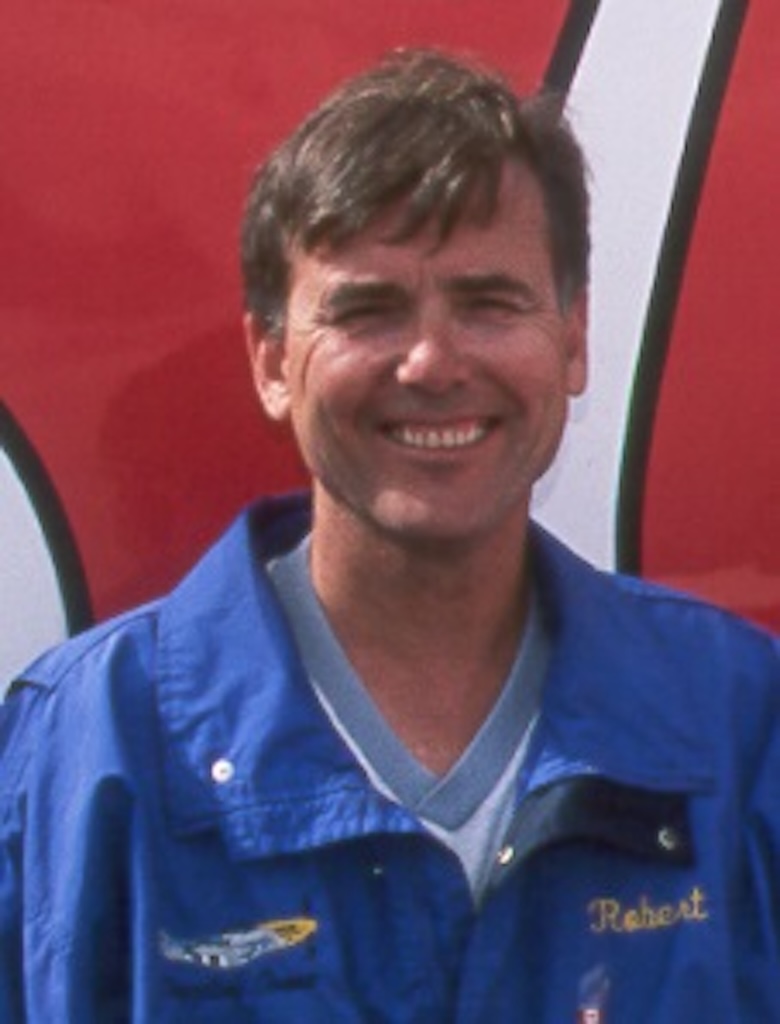
Sure enough, one morning at Reno in the Invitational’s chalet on the Stead Field ramp, as Odie and his friend, Gerry Beck came through the tent, Kaplan beckoned them aside. “Bob, we have something going on at the Hall of Fame that’s run into a snag, and we think you may be able to help,” he said. Then Kaplan went into his Duggy the DC-3 and SkyReach elevator pitch, by this time finely honed from numerous presentations. As he would launch into explaining the various aspects of a flying DC-3 being used to teach kids about aviation, to Kaplan’s astonishment, a grinning Odie would excitedly finish Kaplan’s sentence. Then, closing with acknowledging that Odie possessed not one but two airworthy DC-3s, Kaplan asked if perhaps he would entertain leasing one for conversion and use as Duggy for a trial year. He was gobsmacked when Odie blurted out, “I don’t want to lease you one – I want to be your partner!”
What Kaplan had not been aware of, up to that meeting, was Odie’s frustration that the events of 9/11 had tanked a hard-earned deal struck with Coca-Cola to sponsor both his DC-3s as flying education platforms. As Odie saw it, Duggy and SkyReach were darn near the same program he had pitched Coke, only better, what with the imprimatur of the National Aviation Hall of Fame, its SkyReach youth focus, and a character development curriculum that used NAHF enshrinees as exemplars.
As Kaplan saw it, the convergence was divinely inspired. Details began to get worked out over the coming months, with Carley first heading to Fargo to make a formal pitch. Ultimately, Odie and Carley agreed – the better of his two DC-3s to transform into Duggy was N1XP. Originally serial number 4733, N1XP had rolled off the Oklahoma City factory line as a C-47 in September of 1942. According to DC-3 historian and author, Henry Holden, “It went to Australia and served in the Pacific Wing of the Air Transport Command until the end of the war, when it was sold as war surplus to Wien Air Alaska, in December 1946. In February 1950, the airplane was purchased by the Canadian Department of Transportation and registered as CF-DOT. It remained with the Canadian DOT until Harry Thompson and Robert Odegaard purchased it, restoring it in 1998 in the original colors of a North Dakota Air Guard C-47 and registering it as N1XP. “
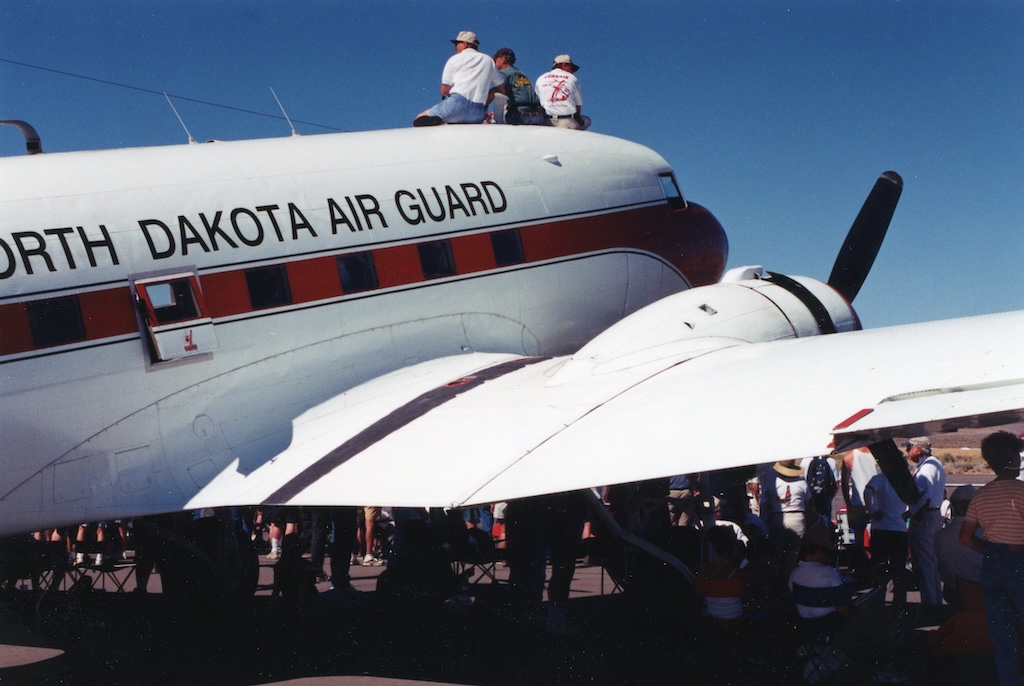
Thus, in March of 2005, just months after Kaplan and Odie’s meeting at Reno, N1XP was in the SkyHarbour paint shop in Canada, with Carley supervising the application of the bright yellow paint scheme and graphics that had previously adorned only his cartoon Duggy. Scaling Duggy up to his new full-size, “real life” role could not have been more exciting, especially as Carley was accompanied by his young teen son, Travis, then not much older than Mitch had been when his imaginative doodling spawned Duggy. Given the massive painting task at hand, the joke at Sky Harbour was soon told that anybody restoring a Piper Cub could paint it any color but yellow.
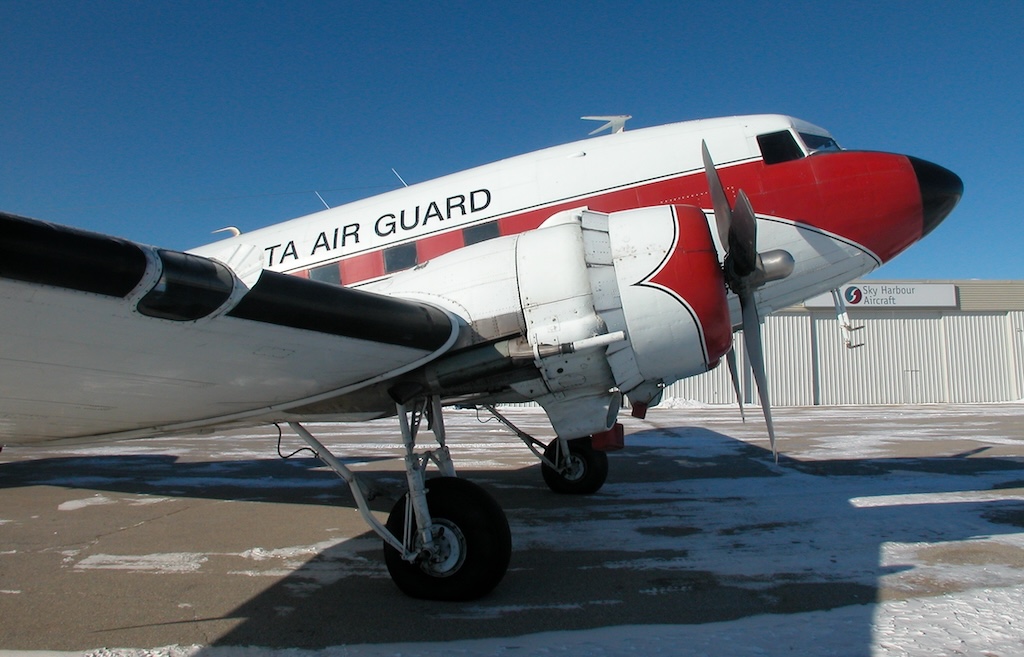
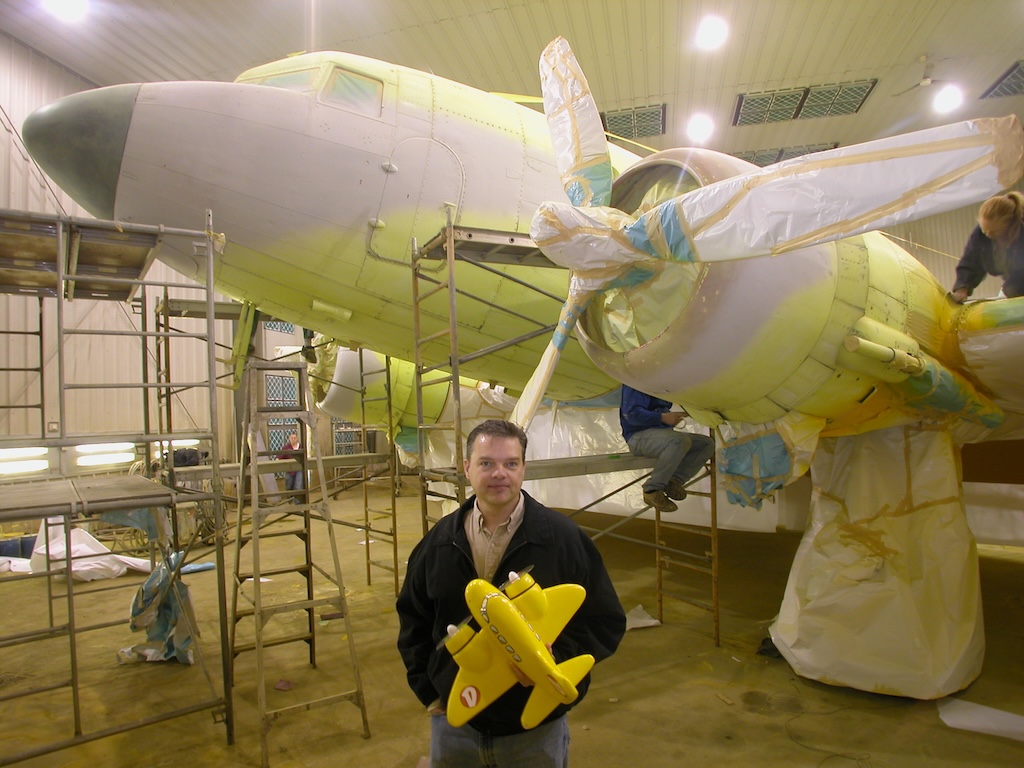
And, with a hint of what lay ahead, local school kids visiting the hangar to see the work-in-progress were enthralled (4c) by Carley’s presentation of Duggy’s story, giving him instant, gratifying indications of what was likely to come once Duggy and SkyReach were introduced to the world. Looking at the air show calendar to determine a suitable launch date, that introduction would ideally take place at the annual week-long Sun ‘N Fun Fly-In at Lakeland, Florida. But that April event was just over a month away. As the exterior paint job was being hustled along in Canada under Carley’s supervision, Carley kept in touch with Kaplan to conceptualize the interior presentation. Panels of text and imagery designed to line the length of the cabin walls would illustrate the DC-3 among a history of flight timeline on one side, the other side highlighting Duggy’s creation and its founding crew, including nods to aviation’s influence on them as youth. (5)
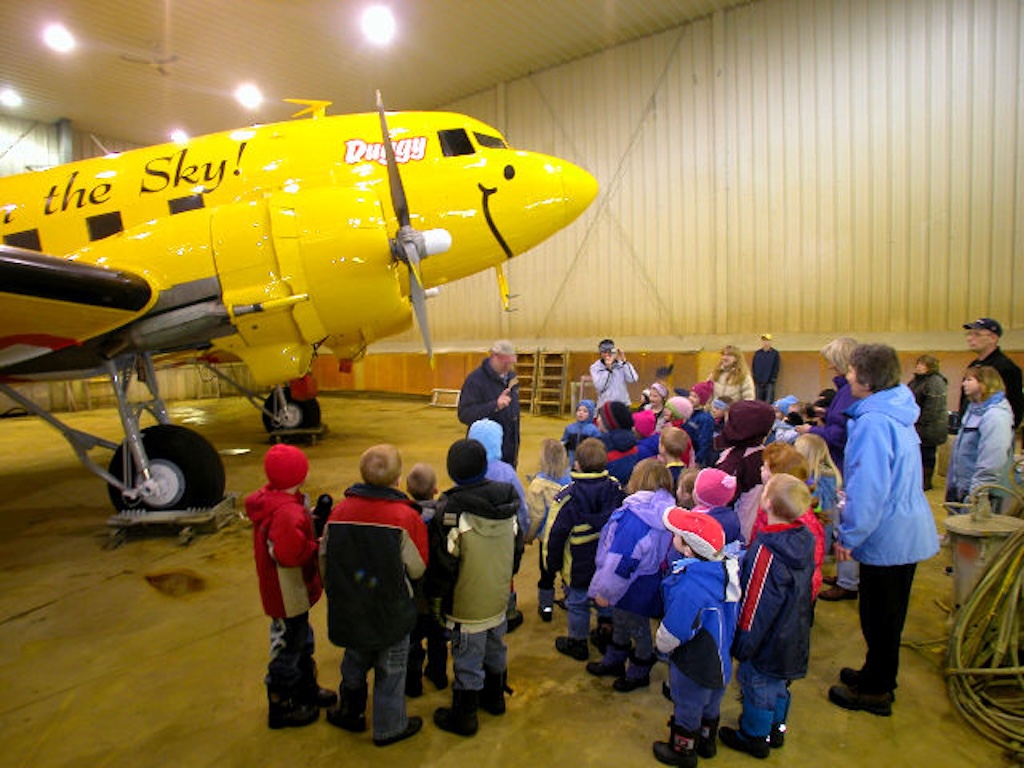

Kaplan, back in his NAHF office in Dayton, eagerly awaited Mitch’s updates from Sky Harbour. As confirmation came that Duggy would be able to make Sun ‘N Fun, albeit just in time for its big, closing weekend, he set about renting a Lakeland house for the crew and priming his media contacts to expect them at the fly-in. Among his supportive NAHF board of trustees was Blair Conrad (5a), whose real job was as Director of Aviation for the City of Dayton. Conrad had flown OV-1s in Vietnam before becoming an airport director at places like Wittman Field in Oshkosh, where he had been instrumental in convincing EAA to build its museum there. An aviation guy through and through, Conrad, as Dayton’s airport director in 2003, had orchestrated funding the creation of replicas of every Wright Brother kite and aircraft by Nick Engler’s Wright Brothers Aeroplane Company for display in a massive pavilion at that year’s massive Centennial of Flight air show. Some of those replicas, including the 1903 Flyer, were currently housed in Nick’s Dayton airport-based hangar workshop.
Conrad suggested that Kaplan and Carley plan a “pre-debut debut” at Dayton International (DAY), making it a stop on the way from Fargo to Lakeland. On the ramp with Duggy would be “Flyer” one of his “Friends,” in the form of a full-scale replica Wright ’03 Flyer, to receive the press along with several busloads of local schoolkids and teachers who would become the first in America to board Duggy as part of the NAHF’s SkyReach program. For the “Birthplace of Aviation,” what more historically significant aircraft could one pair up than a Wright Flyer and a Douglas DC-3? The resourceful Conrad made sure that the airport FBO, not surprisingly called Wright Brothers Aero, provided fuel and oil support for Duggy’s visit. Engler and his team of craftsmen prepared to host the students in their hangar workshops for a hands-on, STEM experience tied to the two iconic aircraft and the NAHF enshrinees who designed them.
Printed Duggy materials emphasizing SkyReach were also being prepared for such public appearances, notably Carley’s design of a “hero card”, an 8.5-inch by 11-inch color cardstock piece that every kid touring Duggy would receive. Information about Donald Douglas, the history of the DC-3, and NAHF SkyReach was on the back. All Carley awaited was a suitable color air-to-air shot of Duggy for the card front, once one could be taken. He also designed a full-color media folder, with its informational contents designed to double as a sponsor pitch kit, as everyone involved realized that the cost of feeding both Duggy’s crew and his two Pratt and Whitney R-1830 radial engines would be formidable.
As soon as Duggy’s paint had sufficiently cured, it flew back home to Fargo. It was there, on a frigid North Dakota day, that Odie and Harry Thompson, with Carley proudly riding along, took Duggy into the brilliant blue skies for its first-ever air-to-air photo flight. With the sun brilliantly reflecting upward off the snow-covered farmland, and from the back seat of a T-6 camera ship, a freezing Doug Anderson, director of the Fargo Air Museum, captured exactly the shot that was needed.
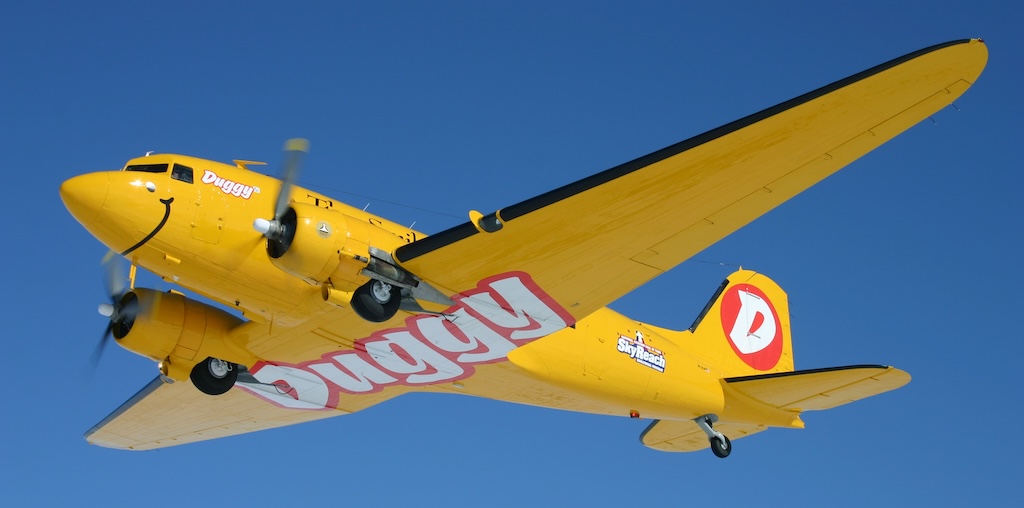
Carley immediately sent the best shot to Kaplan down in Dayton. Off to the printing presses, the Duggy materials went. (6a) Embroidered black-and-yellow ballcaps and crew shirts (quickly dubbed “bumble-bee shirts”) were ordered and personalized, Odie identifying him as “Captain Bob.” The date for the pre-debut in Dayton was set for April 7.
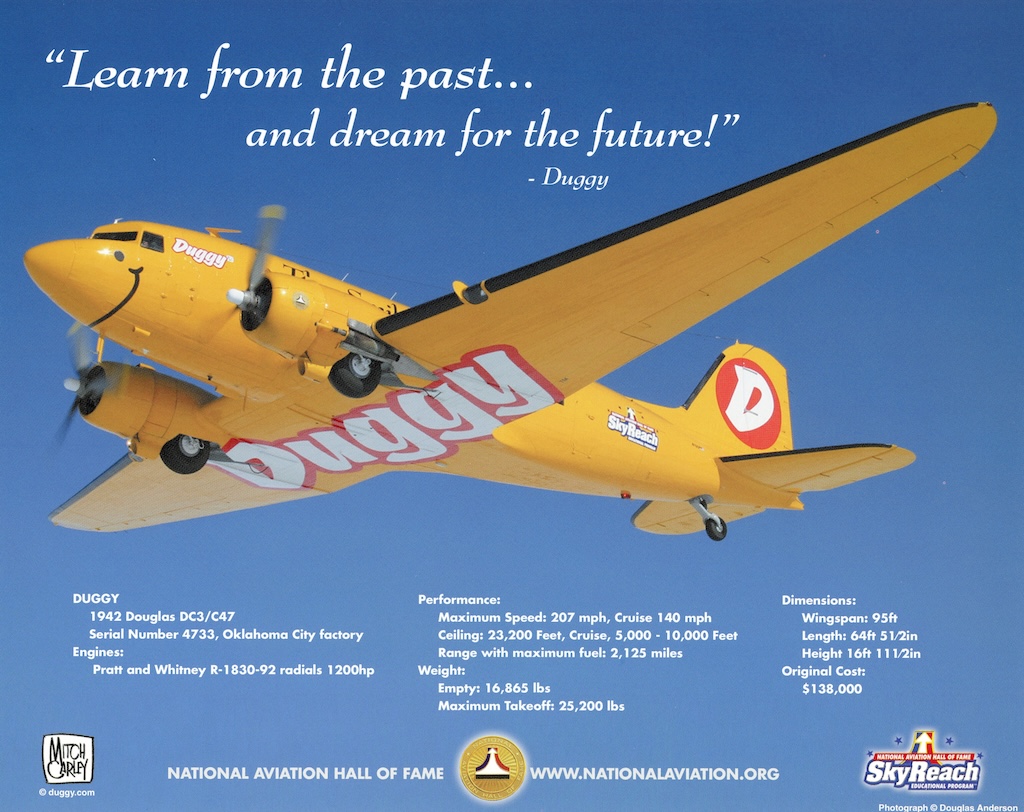
For Carley, Kaplan, Odie, and his crew, things were now getting real, real fast. Odie and Thompson, with Challans joining them in Fargo, packed up Duggy for the extended journey south, which would begin with a 0-dark-30 departure so as to arrive late morning at DAY for the welcoming festivities. Carley returned to Ohio to accelerate the design and printing of the cabin displays (that unfortunately would not be installed until after Sun ‘N Fun). Engler’s shop prepared their ’03 Flyer for display, and hands-on activities were prepared for several local junior and senior high school groups that were being invited. At long last, the big day – April 8, 2005 – arrived. Early spring in Ohio can be beautiful but chilly, as it was that brilliantly sunlit morning when hundreds of schoolkids, their teachers and chaperones, NAHF staff and trustees, airport staff, and local media representatives stood shivering on the ramp outside the open Wright Brothers Aeroplane Company hangar door. Duggy and crew were inbound, and a fixable mechanical issue had delayed their take-off from North Dakota. STEM activities in the hangar commenced early to placate the mob of youngsters, hyped with anticipation of meeting the real Duggy. Basking in the sun before them was the Wright ’03 Flyer replica, a small corps of volunteers standing by for crowd control and prepared to conduct the first tours on the ramp. Soon, the chugging sound of the big round radials was heard from across the airport. Triggering everyone’s excitement level, the chill was forgotten as they crowded up to the safety rope to watch Duggy, his propellers, big sunlit discs, taxi toward them, and the awaiting Flyer.
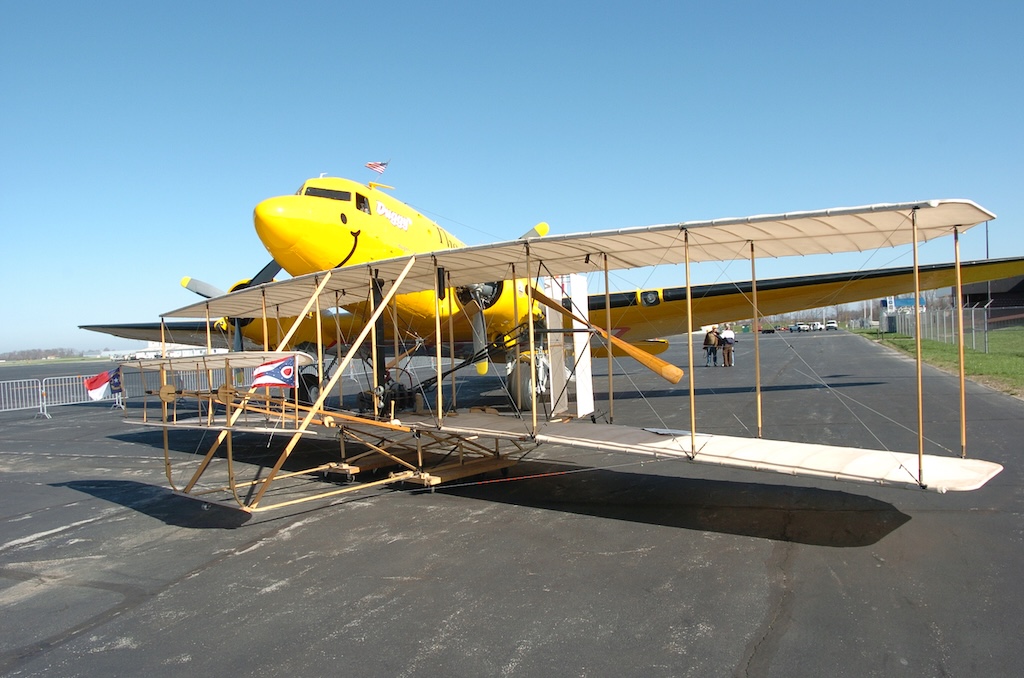
Duggy’s props came to a halt, and the cheering crowd could be heard. It was hard to tell who had the biggest smile – the crew, the audience, or the brightly shining yellow transport. After Kaplan and Carley welcomed the crew, introduced them, and made some introductory remarks, the rope came down and NAHF volunteers proceeded to tour eager gaggles of schoolkids aboard Duggy. Meanwhile, other groups examining the Wright Flyer replica received a history lesson from craftsmen who built it. Workstations set up in the hangar included Engler and his team, as well as special guest presenters like Airbus 330 captain Connie Tobias. (7a) Just a year before, she had successfully piloted the powered ’03 Flyer replica in Dayton (and a replica 1909 Bleriot).
Meanwhile, the local press interviewed Odegaard and Kaplan as organized groups of students in the hangar were led from activity station to station. Conrad, along with several of his fellow NAHF trustees there to see Duggy “in person,” happily monitored the bustling scene inside and outside. Kaplan beamed, too, though largely with relief. He was especially grateful to have the NAHF’s ace photographer, Mike Ullery, covering the controlled chaos of the historic event for the NAHF’s membership magazine, Heroes & Legends, and for posterity.
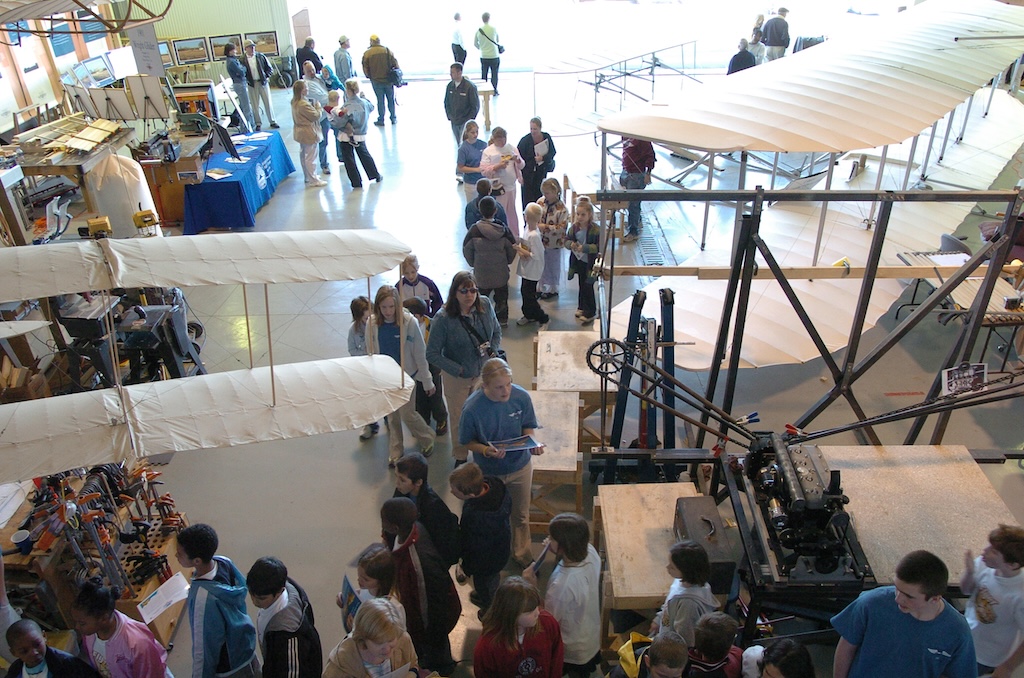
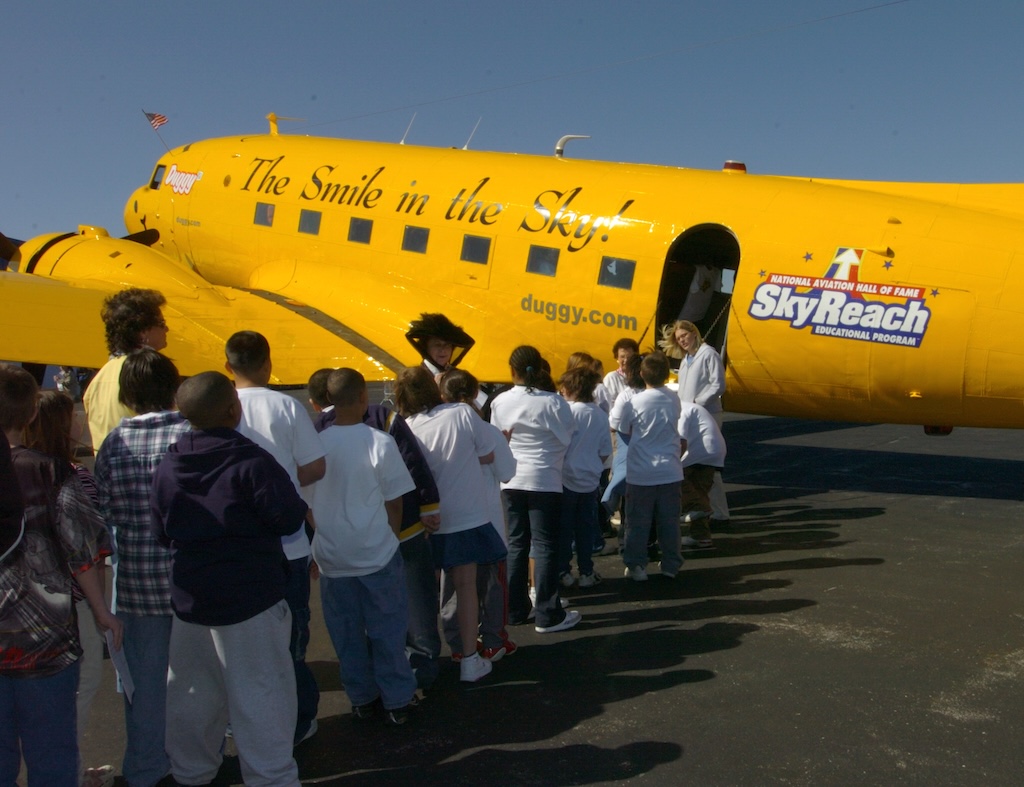
As Duggy’s crew graciously dealt with the attention, they also had an eye on the clock and the weather. The tight schedule called for Duggy to depart DAY for Lakeland, with an overnight stop in Sevierville, Tennessee, for fuel and a photo opportunity. Kaplan, recently promoted to Executive Director, would fly to Lakeland commercially the next day to join them at Sun ‘N Fun after taking care of NAHF Learning Center business. When “The Smile in the Sky” lifted off from Dayton International, hundreds of new fans were left behind. The number of fans increased exponentially at Sun ‘N Fun, where the big yellow guy was received like a rock star. The crew was nearly overwhelmed by the attention. The minute Duggy taxied into place and shut engines down, mobs of spectators surrounded the plane. Almost immediately, educators wanted to know more about SkyReach and bring their classes for a presentation. Sun-N-Fun officials quickly moved Duggy closer to the main entrance, making access to Duggy easier for the steady stream of school groups coming off their buses in the parking lot.
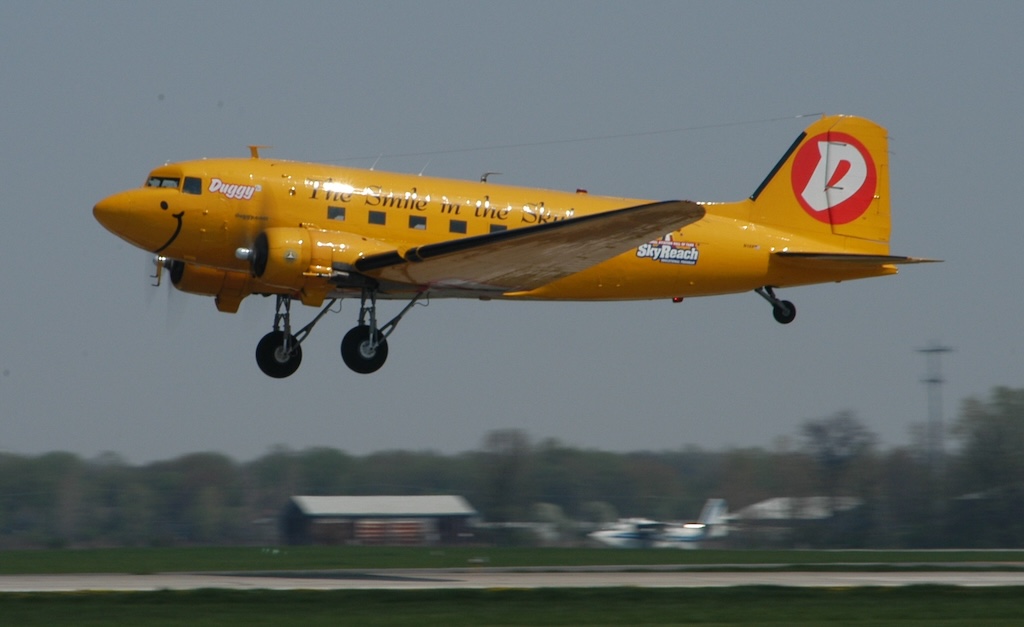
With the cabin graphics set to be installed sometime in early summer, Carley set up shop next to Duggy, equipped with his SkyReach display board and an ample supply of hero cards and stickers to dole out. He was in his element as he stood under Duggy’s nose or by the cabin door, (7g) again and again hosting mobs of kids, teachers, chaperones, and the curious who eagerly absorbed his tales of Douglas, the airplane, Duggy’s friends, and more.
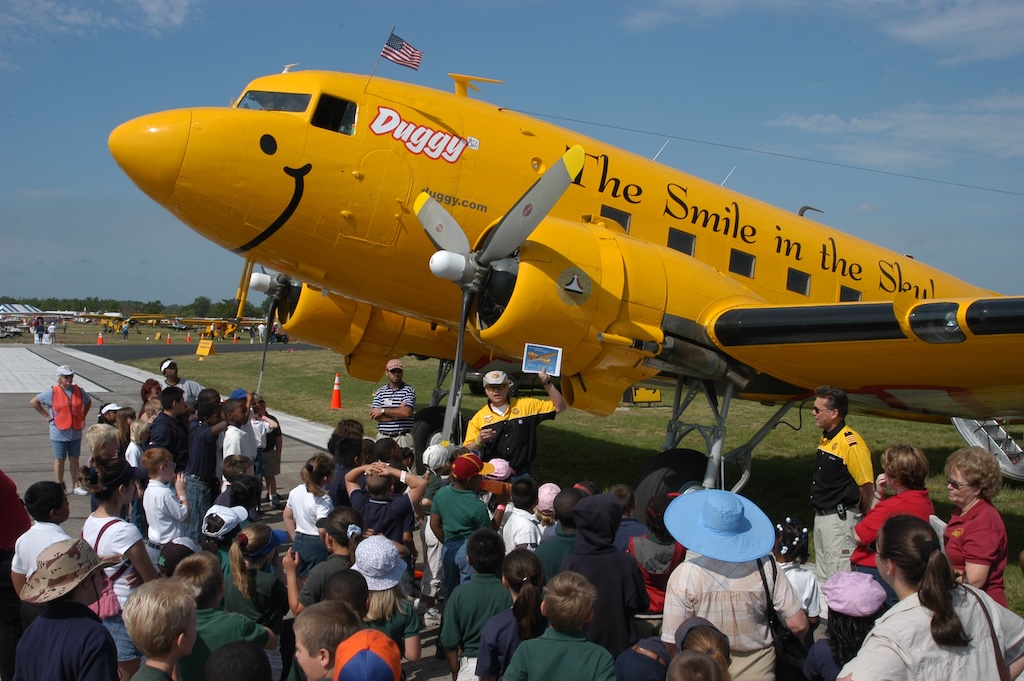
Meanwhile, a couple of volunteers from the NAHF at Sun ‘N Fun assisted the crew in leading visitors through the cabin and a brief stop at the cockpit. For many of the kids, it was their first time aboard an airplane of any kind. Bemused, Odie, Thompson, and Challans adjusted to the unexpected attention, patiently fielding relentless requests from wide-eyed, hero card-wielding youngsters seeking their autographs. Often, they listened as older gentlemen shared treasured tales of their own DC-3 and C-47 memories, be it their first flight as a youngster, or as a young airline captain, or as an airman flying over jungles of Vietnam. They just kept coming.
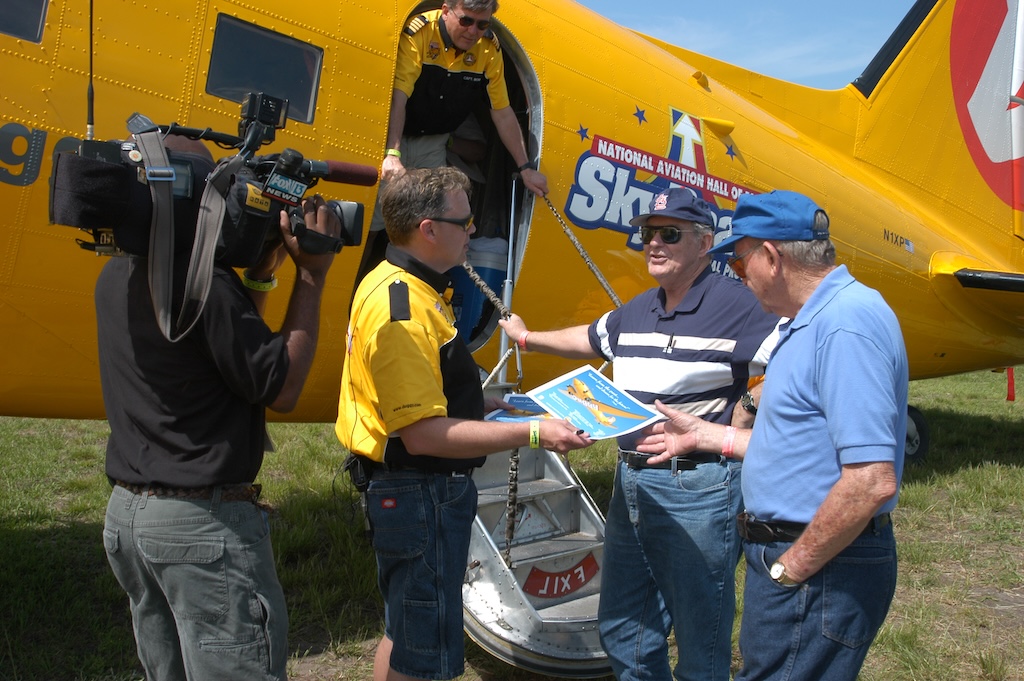
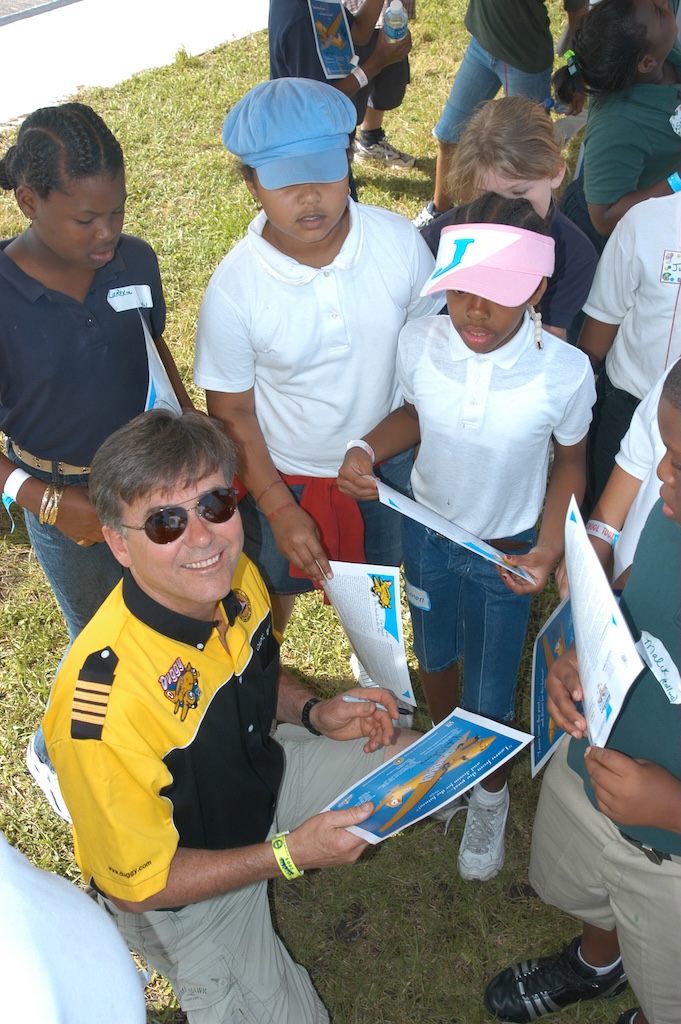
So did the media and photo requests. No strangers to the world of warbird publications and photographers, Odie and Harry had Duggy’s dance card filling up with dawn patrol and sunset air-to-air shoots over central Florida by the likes of James Lawrence and Paul Bowen. Meanwhile, Kaplan happily handled scheduling the crew for interviews with print and broadcast news outlets, including the Spanish cable news program, Telemundo, all eager to document the Duggy story for their audiences.

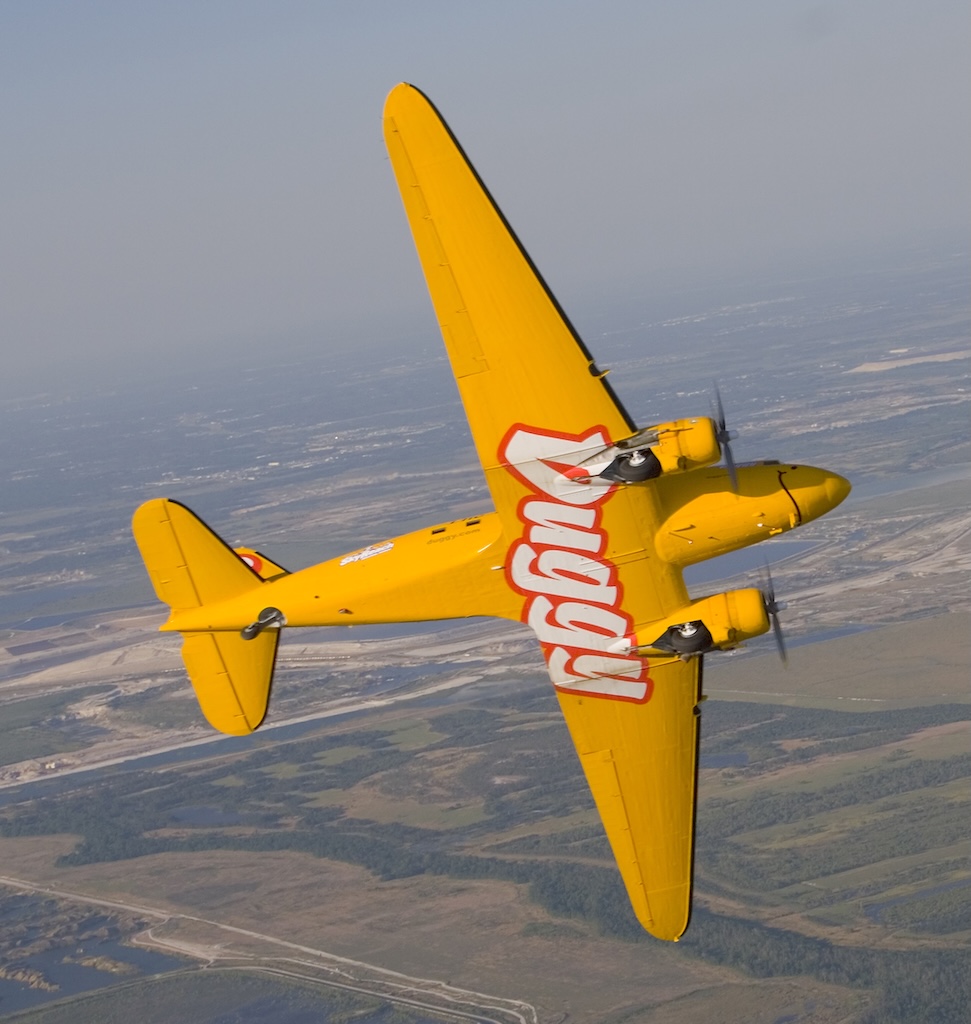
A fun side trip for Duggy’s team was made at the invitation of Jimmy Leeward, a well-known Unlimited Class air racer and warbird pilot who, every year during Sun-N-Fun, hosted a warbird barbecue at his home airpark in nearby Ocala, the Leeward Air Ranch. The 6,000 square foot-plus grass runway, lined by homes with hangars facing the strip, was quite a laid back contrast to the controlled chaos happening back at Lakeland Airport. Still, the variety of warbirds joining Duggy in making low passes – aka “cutting the grass” – at Leeward’s was impressive.
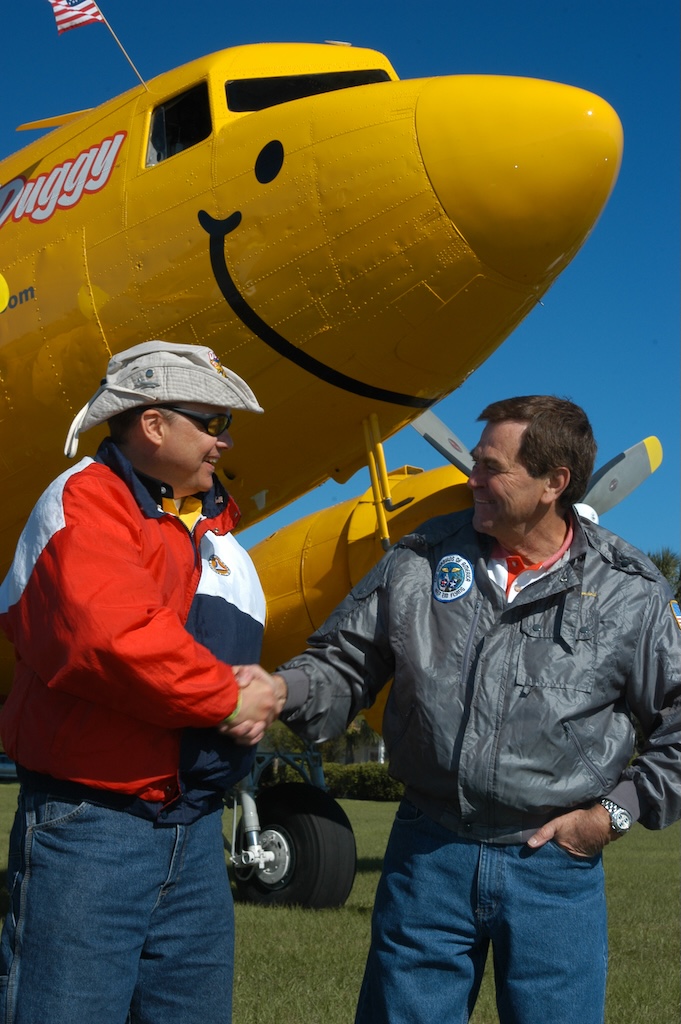
Kaplan knew in advance that a couple of NAHF enshrinees were participating in Sun ‘N Fun, notably legendary test pilot Scott Crossfield and, performing in the air show, aerobatic champion Patty Wagstaff, and invited them to stop by to meet the crew and tour Duggy. Both were thrilled to see the NAHF’s new “flying ambassador” in action. Though no one recalls just who thought of it, Crossfield, the first enshrinee to tour Duggy, was handed a Sharpie and asked to autograph Duggy’s bulkhead. Soon after, Patty Wagstaff added hers. Thus, a Duggy VIP visitor tradition was born.
Besides being hard to miss at the entrance to Sun ‘N Fun’s ramp full of classics and warbirds, Duggy seemed to create an aura, adopted as a landmark of sorts for Sun ‘N Fun participants. With the buzz of happy crowds always about, it made a natural gathering place. The crew, bedecked in their distinctive black-and-yellow uniform shirts, became magnets to throngs of children seeking their autographs, Duggy and Friends stickers, or to pose for photos. Crossfield, a frequent visitor, was often seen holding court with old and new friends under Duggy’s nose. On the occasions Duggy took to the skies for a photo mission, marshallers corral the smiling, waving crowds of young and old alike as Duggy chugged his way to takeoff.
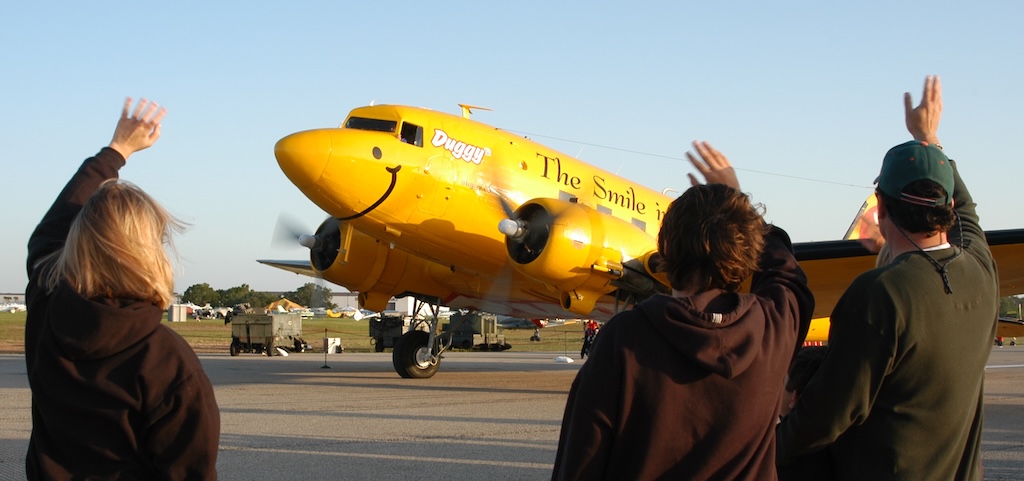
Kaplan happily phoned back to Dayton with news of Duggy’s triumphant debut and reception. Conrad and other fellow NAHF board members who witnessed Duggy’s Dayton success were not surprised, offering their congratulations to pass on to the crew. But Kaplan recalls his most endearing acknowledgement came on the final day of Sun ‘N Fun, when Crossfield summoned him over to his covered golf cart, from which he had been observing the morning’s never-ending queue of young and old lined up to tour Duggy. Kaplan had great respect for Crossfield, whom he had worked with on numerous occasions since joining the NAHF staff in 1998. Crossfield told Kaplan to take the seat next to him. “You know what I think?” Crossfield asked, gesturing at the spectacle of Duggy, the crew, and volunteers, as well as the fans before them. “I think THIS is going to be the hallmark of the National Aviation Hall of Fame.”
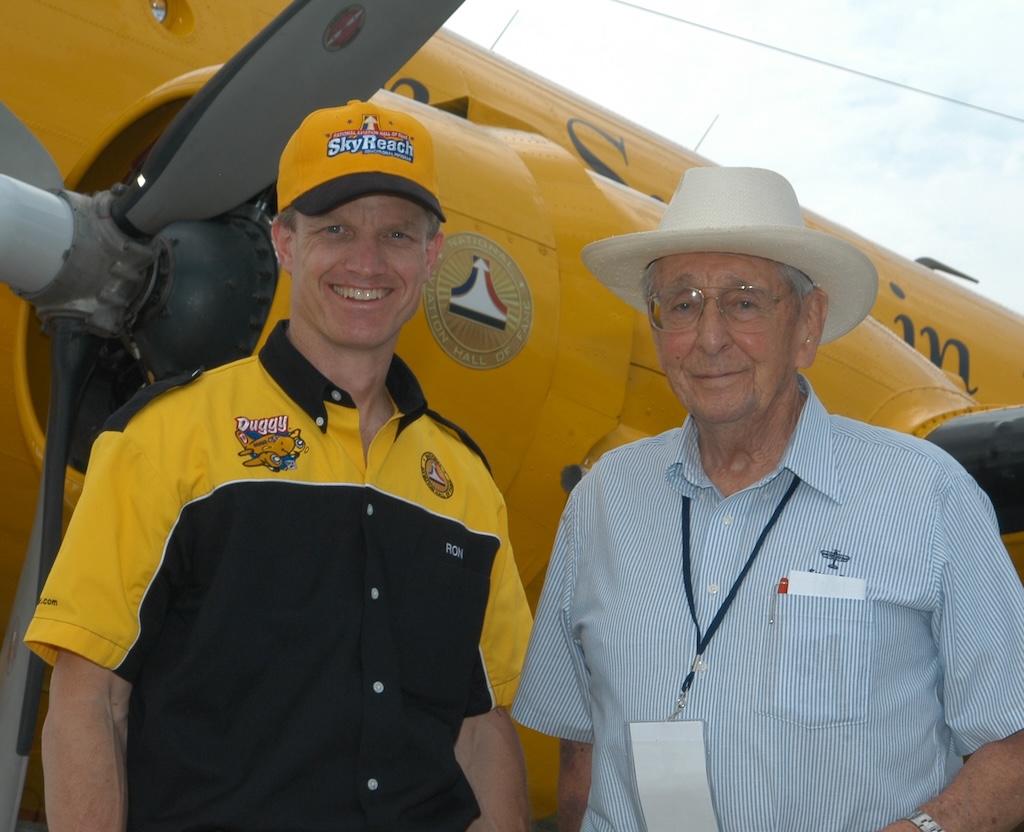
Kaplan sincerely thanked Crossfield for his kind comments and promised to share them with his staff back in Dayton, as well as the Duggy crew and volunteers. Coming from such an accomplished aviation pioneer, Crossfield’s endorsement was a wonderful tonic for the now-exhausted team, preparing to make their way northward to Ohio or to North Dakota. The three-way operational agreement between the NAHF and its SkyReach program, Carley as the owner of trademarked Duggy and Friends, and Odegaard as the operator of N1XP, was to last through 2005. The terms would be extended if sufficient funds were raised and sponsorship support secured by the end of the year. Given the reception Duggy received at Lakeland, confidence was high that such support would be found before the year was over.
By the time Sun ‘N Fun concluded, Kaplan and the Duggy team had a pretty good idea of “can’t miss” appearances on their list of shows for the flying SkyReach program. In fact, Odie was approached by air show promoters while at Lakeland, inquiring about booking Duggy. Back in Dayton, Conrad, battling cancer but soldiering on in true Army Aviation style, organized support and resources to ensure that Duggy would bring SkyReach to the Dayton Air Show, held the third weekend of July. This meant the crew could attend the NAHF’s annual enshrinement dinner and ceremony, known as “America’s Oscar Night of Aviation,” held in downtown Dayton the same weekend. From Dayton, the team would head straight to Oshkosh for the EAA Convention and Fly-In a week later. The next “can’t miss” stop after Oshkosh would be in September at the Reno Air Races. Though not competing for an Invitational trophy, Duggy would be an attraction among the gaggle of vintage restorations being judged. It would be the same site on which, just a year prior, Kaplan had first made to Odie his SkReach appeal pitch to lease a DC-3. Last but not least of such Duggy/SkyReach appearances would be on December 17, 2005, at Santa Monica Airport (SMO) in Los Angeles, where once stood the Douglas Aircraft Company factory, to cap the year in historic style. Kaplan was keenly aware that the date marked the 70th anniversary of DC-3’s maiden flight from that very airport. What more appropriate date and place to conclude Duggy the DC-3’s inaugural tour?
Back when Kaplan met in L.A. with Josephson the year before, he had stopped by the Santa Monica Museum of Flight to visit its director, Dan Ryan, whom he had known for about 10 years. In catching up, Kaplan spoke of Duggy’s tour. Ryan shared with Kaplan that the museum’s founder, David Price, had recently donated a DC-3 to Santa Monica, in fact naming it “The Spirit of Santa Monica.” (it’s actually a C-53 variant of the type, originally delivered from the factory to the Army Air Corps in 1942). Volunteers were now preparing for an outdoor static display, the centerpiece of a proposed plaza adjacent to the museum, to honor Douglas and his long-gone factory. Ryan introduced Kaplan to Price, figuring there might be something worth exploring.
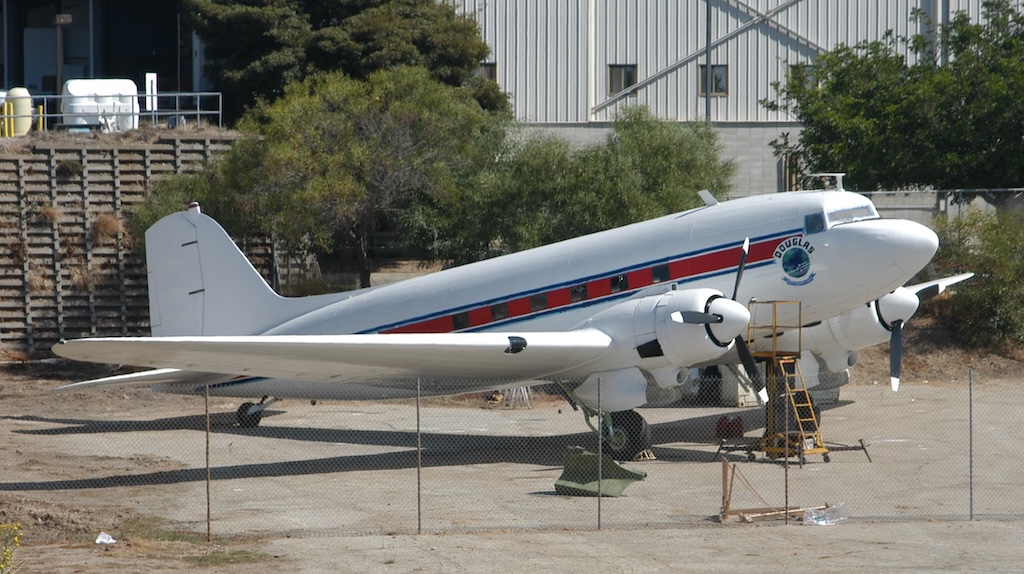
With Duggy’s triumphant launch now well known throughout the aviation community, Kaplan posed to Price, himself a former Naval aviator and record-setting air racer, the idea of Duggy organizing other DC-3s to participate with it in a flyover to mark the anniversary. Price, in turn, introduced Kaplan to SMO airport director, Bob Trimborn, whose charge was to plan the memorial plaza’s groundbreaking ceremony on December 17, 2005 – the DC-3’s 70th anniversary. Thus, over the coming months, the two laid plans for that last “can’t miss” event of 2005 while Duggy worked his way westward.
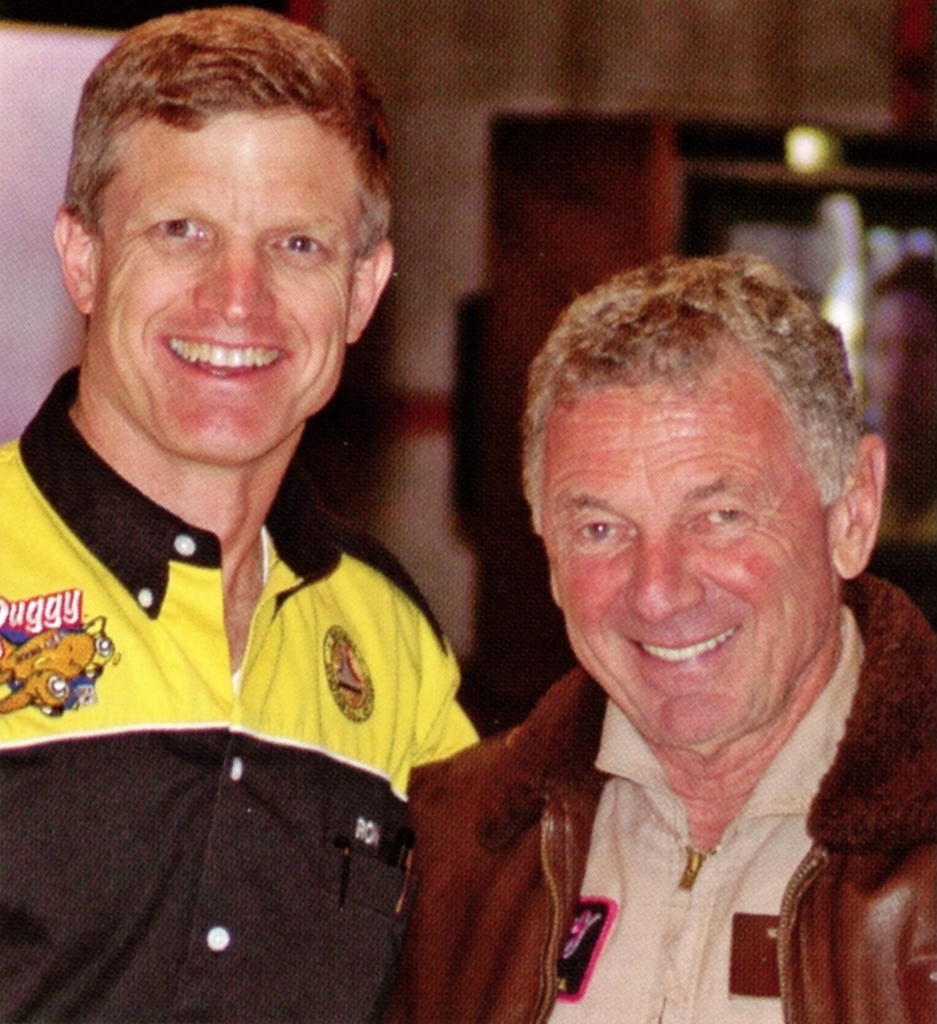
Fueled by the massive media coverage Duggy garnered at Sun ‘N Fun, by the time hot July in the Midwest and the Dayton Air Show rolled around, “The Smile in the Sky” was a featured attraction. Sponsorship support for the Dayton Air Show appearance came from the Wright Brothers Aero FBO and the airport, thanks again to Conrad. Sadly, his cancer had progressed such that he was under home hospice care, friends and family by his side, relaying word of success phoned from the crew. Kaplan was told later that Conrad, even in his weakened state, expressed his approval of their good news. On Friday night of the show weekend, Kaplan and the NAHF hosted the Duggy crew at the traditional, pre-gala hangar barbecue at Moraine Air Park, a chance to casually mingle with the early arriving honorees and enshrinees like astronaut Joe Engle, Betty Skelton and Tex Hill. The next night was the black-tie enshrinement dinner and ceremony, held at the Dayton Convention Center. By design, the crew wore the bumble-bee shirts, standing out from several hundred black-tie attired guests who treated them like the other aviation royalty in the crowd.
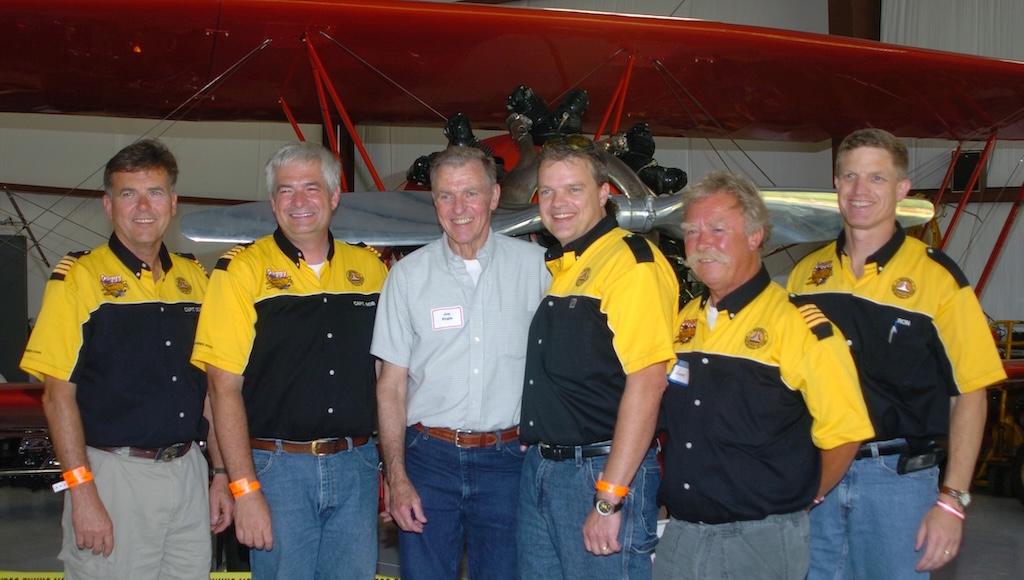
SkyReach volunteers from the NAHF working the Duggy duty were led by an indomitable retired and married couple of pilots from Dayton, Jack and Betty Darst. They nearly exhausted themselves shepherding thousands through Duggy over the hot and steamy three-day event. The Darsts would benefit from the practice, as just a week later, they’d be following Duggy up to Oshkosh for EAA AirVenture, a week-long convention and air show typically attracting over 600,000 people. And at Oshkosh, Duggy would be impossible to miss. Odie received word that not only would Duggy be placed on the famed Aeroshell Square, the centrally located ramp showcasing the fly-in’s most significant aircraft on static display, but Duggy would fly at least once each day, dropping the Liberty Jump Team for the traditional show-opening National Anthem. Kaplan, who had been attending Oshkosh since 1992, was thrilled. EAA was huge on youth initiatives, and SkyReach was going to get a LOT of attention, as well. Sadly, just days before the start of AirVenture, Kaplan shared news with the crew that Conrad, at age 58, had passed on July 23rd. The timing was ironic given that his first civilian job was as Wittman Field airport manager, Oshkosh, and EAA was long near and dear to Conrad and his family. The entire Duggy team was surprised and heartened to soon learn that Conrad had made a generous donation to help support their AirVenture appearance. For those unfamiliar with the scale and importance of Oshkosh to the aviation community, suffice it to say, as Carley would put it, it’s off the hook. Staff support, let alone all the logistics, can be a challenge. Such a massive, week-long event calls for all hands on deck, and Odie fortunately had additional seasoned crew in his own family and warbird network. Along with his wife, Donna, Odie’s sons, Casey and Brady, and daughter Halley, joined Challans and Carley, who also had his son along. Odie enlisted his friend and fellow high-time warbird pilot, Doug Rozendaal, for good measure. (11)
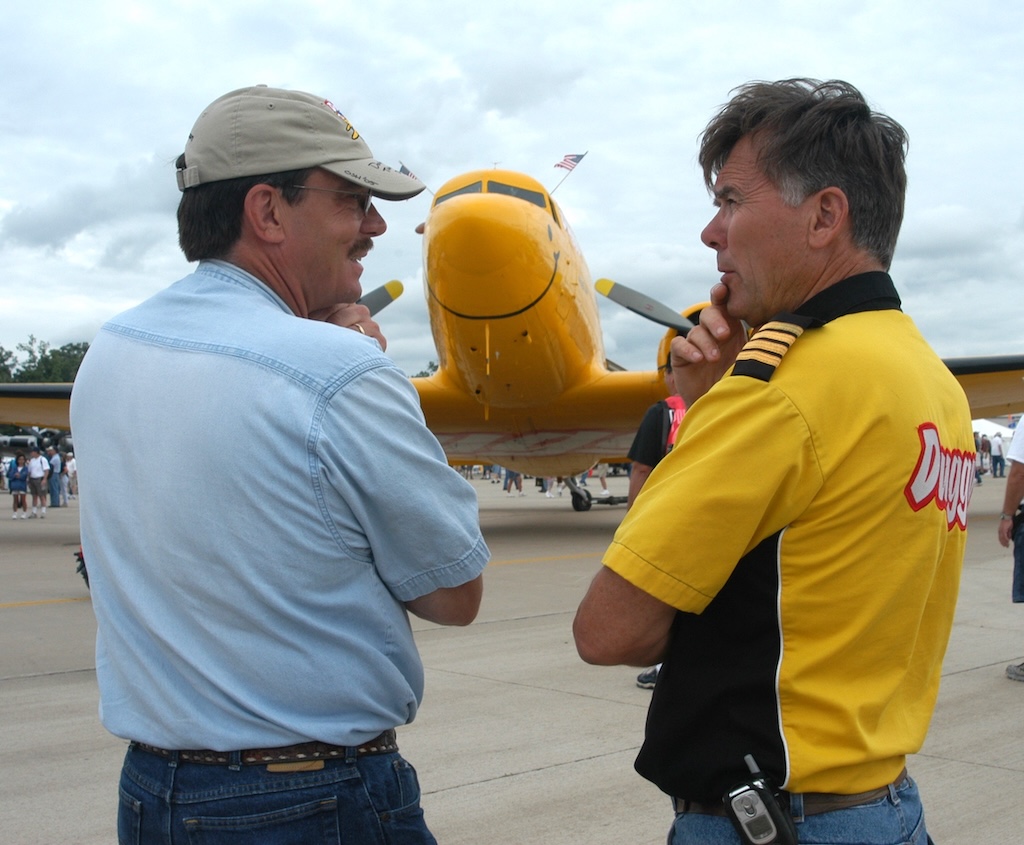
Kaplan similarly had to man up to execute the NAHF’s SkyReach mission through the week, which included managing a tent on the Aeroshell Square ramp in addition to Duggy’s operations when the aircraft was on static display and open for tours. His crew of eight staff and volunteers for the week included the indispensable Darsts and photographer Mike Ullery. The NAHF rented a couple of houses for those who did not have their own lodging secured. In the case of the Odegaard party, Kaplan found a large custom home near Lake Winnebago that comfortably accommodated their party of eleven. He recalls that the owner’s tiki bar in the three-car garage was a popular feature. Keeping with a tradition of his that began ten years prior, Kaplan lodged at the home of his friends, the Kujawa Family, who lived just a block from Basler’s FBO on Wittman Field. Duggy may have been but one of 10,000 aircraft arriving for the show, but he immediately became a favorite on the ramp. Being parked throughout the week, variously next to record-setting aircraft like SpaceShipOne, its White Knight mothership, and the Virgin Global Flyer did not hurt. Also nearby was the P-38 ‘Glacier Girl,” which had won the 2003 Eastern Regional Invitational trophy as well as the NAHF’s People’s Choice Award at Dayton. Odie also brought his F2G-1D Super Corsair “#57”, displayed with a couple of other Unlimited Class Reno air racers that flew in the show together. Duggy found himself at the center of an aviation buff’s smorgasbord.
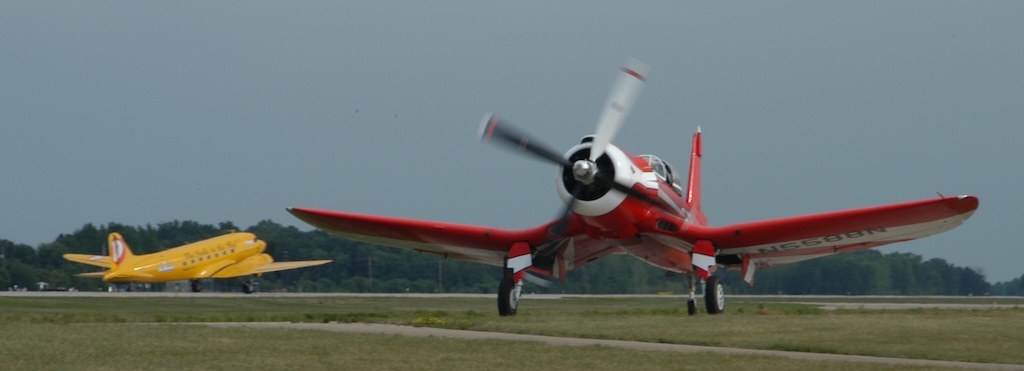
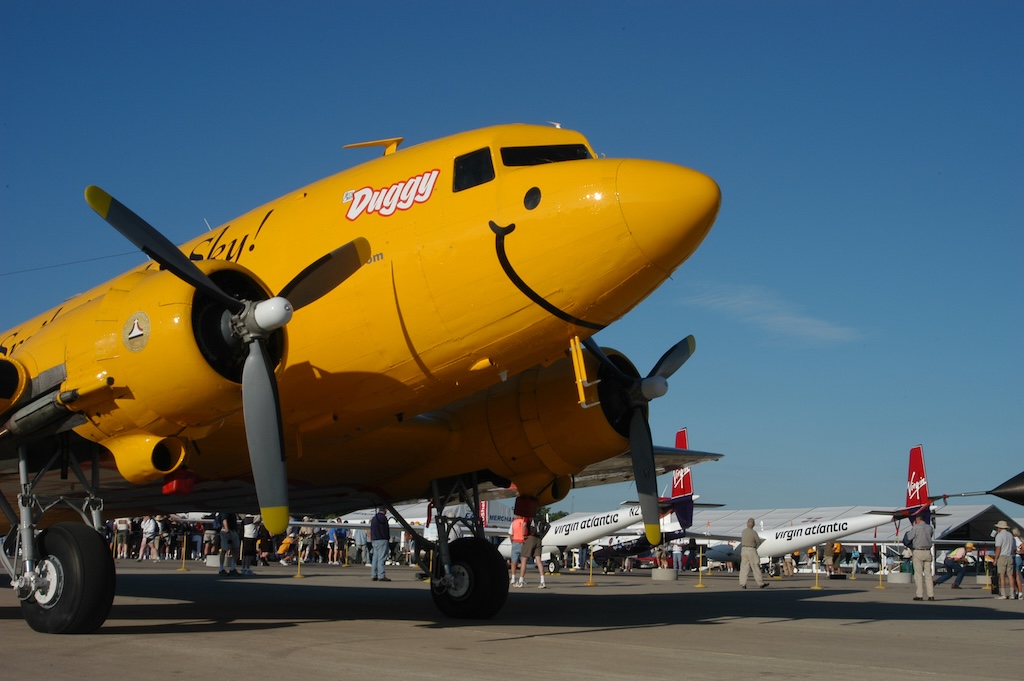
And being Oshkosh, a who’s who of air and space luminaries were there including NAHF enshrinees Burt and Dick Rutan, Bob Hoover, Chuck Yeager, Robin Olds, Patty Wagstaff, Paul Poberezny and SkyReach advocate, Scott Crossfield. Kaplan and Carley chatted up Sir Richard Branson on the ramp, and were delighted when the niece of NAHF nominee, Steve Fossett, brought her young son for a tour of Duggy. When EAA Young Eagles director Steve Buss invited Duggy’s crew to serve as spotters for the annual Gala’s live auction, they jumped. The Duggy team and SkyReach had already donated a sightseeing flight around AirVenture for 10, accompanied by Crossfield, who was happy to lend his “celebrity” support. David Lau of Watertown, Wisconsin, was the winning bidder. To the delight of Lau and his Duggy entourage flying with Crossfield the next morning, they were greeted upon landing by Bob Hoover.
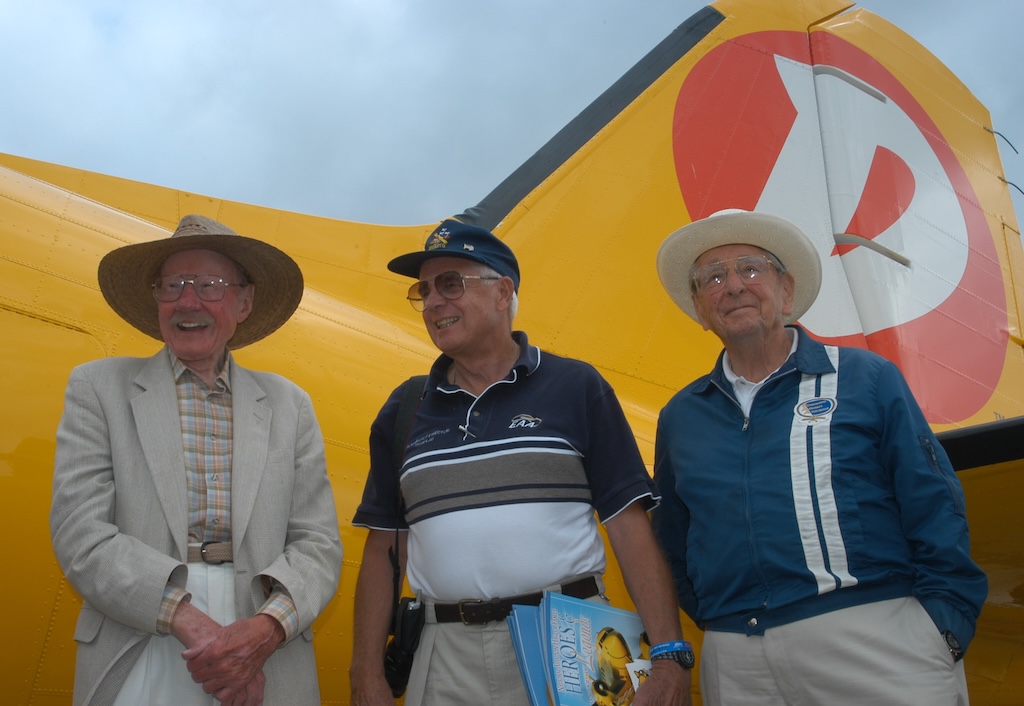
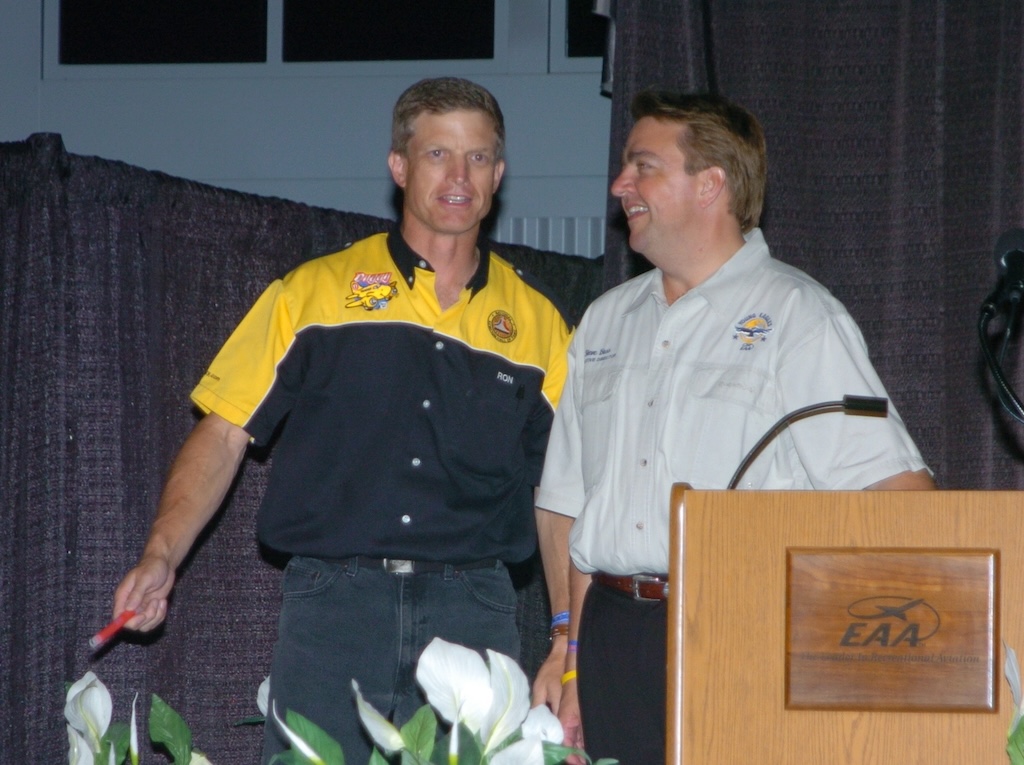
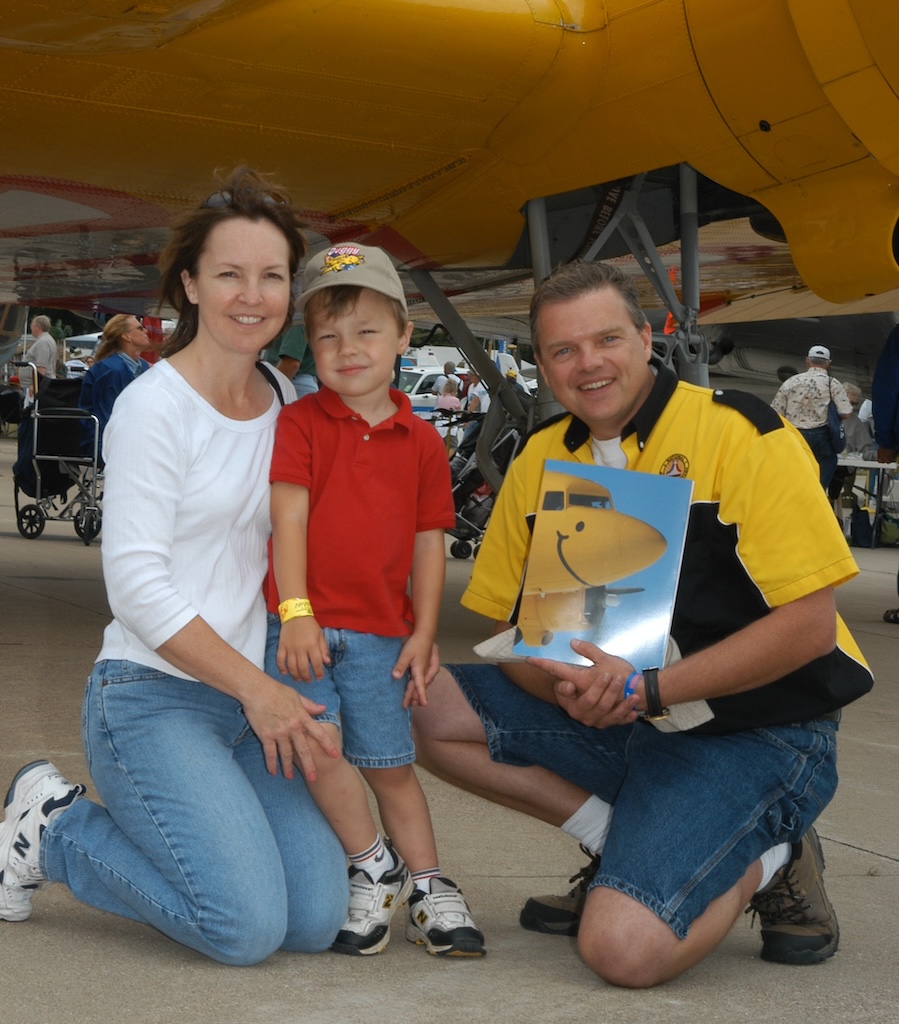
Actor and pilot Harrison Ford, the EAA Young Eagles program chairman, was participating in AirVenture with his wife, Calista, and their young son, Liam. Kaplan and Ford had previously worked together when Ford served as emcee for the NAHF’s “Pioneers of Flight Homecoming” held in Dayton in 2003, a massive gala feting 22 living enshrinees and drawing an audience of over 2,000 guests from worldwide. Upon learning at Oshkosh of Ford’s interest in flying Duggy, Odie, and Kaplan extended an invitation which Ford eagerly accepted. Carley led Ford and two of his pilots through the in-cabin NAHF presentation, Ford readily making the connection between the EAA Young Eagles mission and the “Learn from the past, dream for the future” approach of SkyReach. Once Odie had them aloft and away from the bustling fly-in, Ford – an avowed fan of big radial engines – clearly relished his right-seat time at the controls of the venerable twin-engine DC-3.
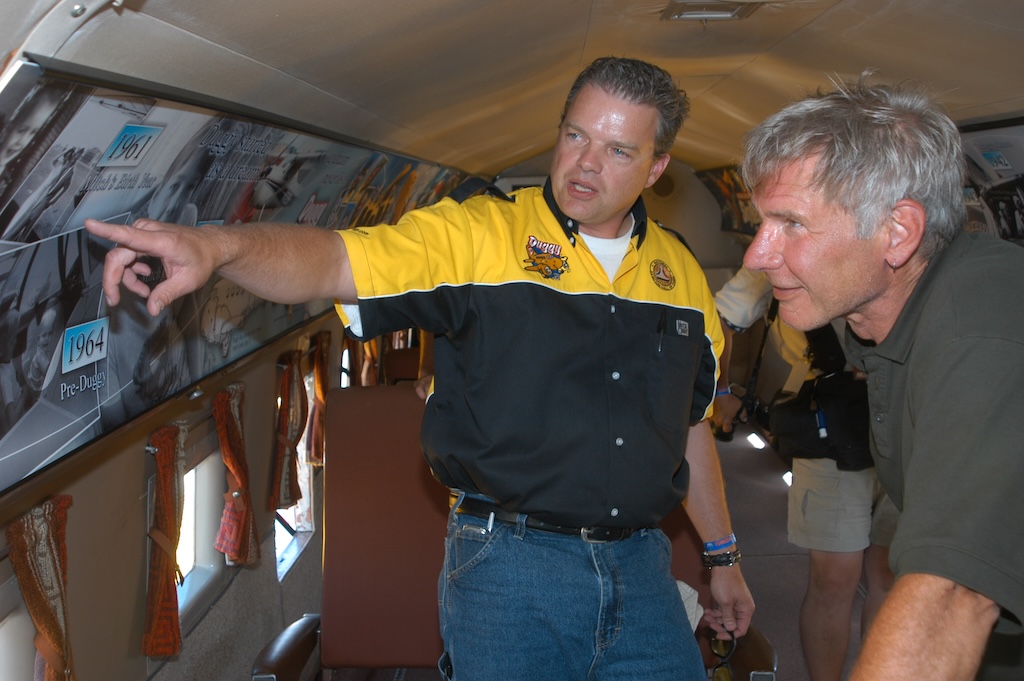
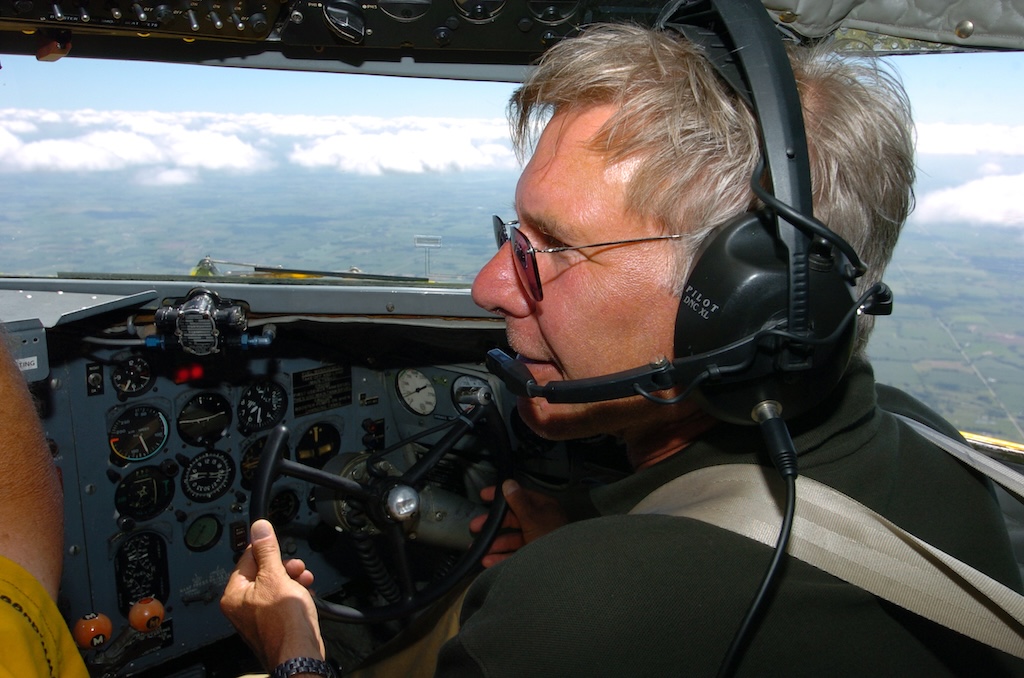
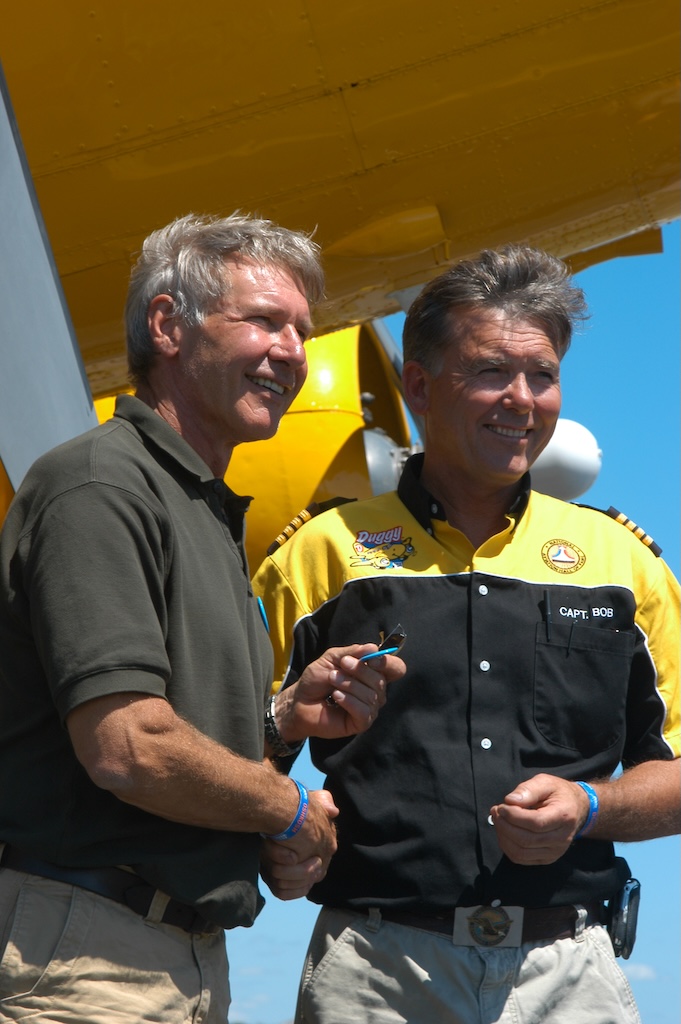
The week of near-perfect weather was one for the record books in every regard. EAA later estimated that some 700,000 attended. To the NAHF staff and volunteers, it seemed as if every one of them had been aboard Duggy. Thousands of hero cards and Duggy and Friends stickers were gone, dozens of hats were sold, and many new fans were made. And added to Duggy’s bulkhead were the autographs of several more enshrinees. For the crews of Duggy and SkyReach, it was another exhausting yet unforgettable event that proved Duggy’s near-magical power.
Unfortunately, however, the expected sponsorship of a corporation or donor did not materialize. Kaplan, who led the effort, met with numerous prospects during the week, including fuel suppliers, manufacturers, OEMs, FBO chains, and more. To a person, they loved Duggy, the concept of his historic “Friends,” and how they attracted youngsters like moths to a flame to aviation history and the SkyReach lessons. Though some of these discussions did not result in a “no,” none had yet become a “yes,” either. However, with all the positive attention and continued media interest, he remained confident it would not be long until some source or two of significant support would step up.

That seemed especially possible with the Duggy crew accepting some invitations from air shows in between AirVenture and the next official Duggy/SkyReach appearance at Reno in September. Reno, in one important aspect, was like Oshkosh. Unlike most other air shows, Reno was attended largely by aviation aficionados and thus attracted sponsors more attuned to that world. Without a limitless budget for SkyReach, Kaplan carefully stewarded the grant money to fund the NAHF’s part of the bargain. Additionally, any “official” appearance of Duggy for SkyReach necessitated additional support in the form of trained NAHF volunteers who would require air transportation to an event. It was not fair for Odie and his crew to have ‘docent duty’ as well, given they were already graciously donating their time to travel while operating and maintaining Duggy.
The NAHF was blessed to have the Darsts, by this time now well-seasoned Duggy tour leaders.The Reno Air Racing Foundation typically hosted a couple of thousand grade schoolers on site, and air race CEO Mike Houghton was delighted that Duggy planned to be open on the ramp. As Kaplan was putting the SkyReach plans for September at Reno together, the Darsts volunteered to fly their Piper Arrow from Dayton to Reno and coordinate touring the busloads of students through Duggy. Kaplan had double duties as both NAHF director and as deputy director of the Invitational, where Duggy would be a prominent fixture among the couple of dozen vintage aircraft vying for trophies.
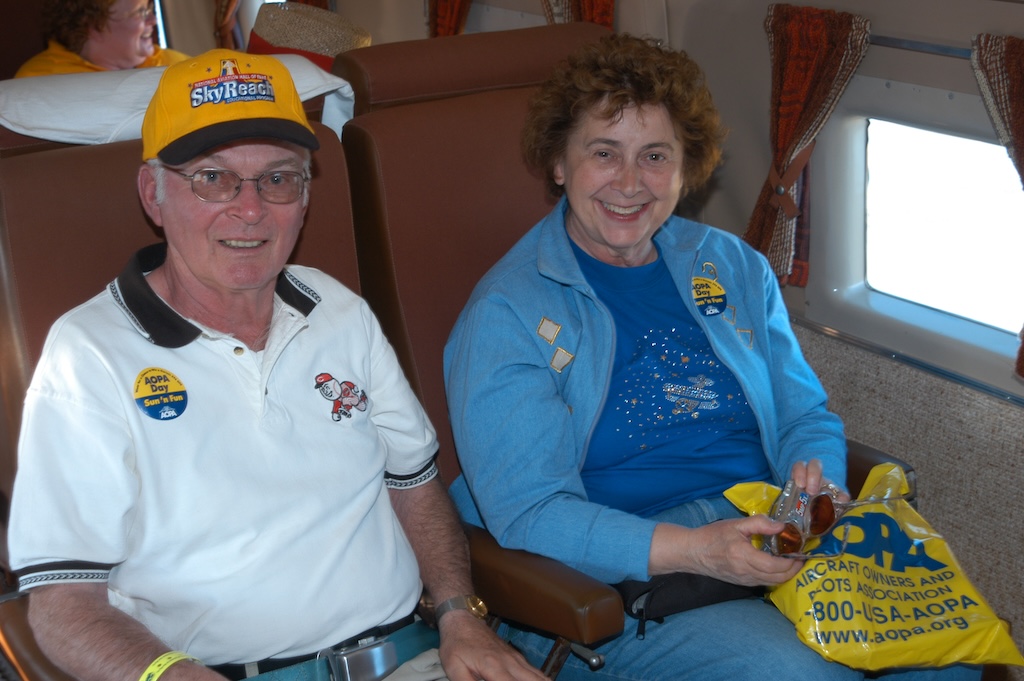
And among the enshrinees there for the Invitational were going to be Neil Armstrong and Gene Cernan, the first and last men to walk on the moon, and nominees Herb Kelleher and Clay Lacy. (13aa) Add the National Championship Air Races and the 60,000 or so spectators that come with it, and Reno was sure to be an epic gathering.
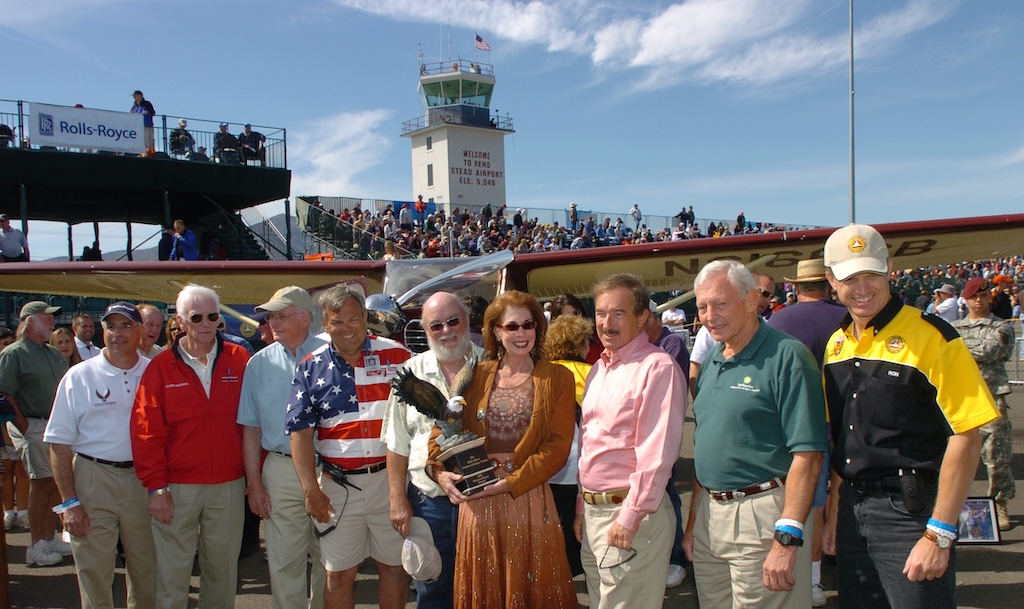
Thanks to Ken Perich of Rolls-Royce North America, also the Invitational’s Executive Director, some support from Rolls ensured Duggy proudly took its place among the Invitational. With Odie’s Race #57, parked nearby, the pair made quite a color combo in the bright desert sun. As anticipated, a steady line of kids and adults made their way in and out of Duggy, the Darsts working nearly without rest in the hot cabin (13c) to share both Duggy’s history and the tenets of SkyReach.
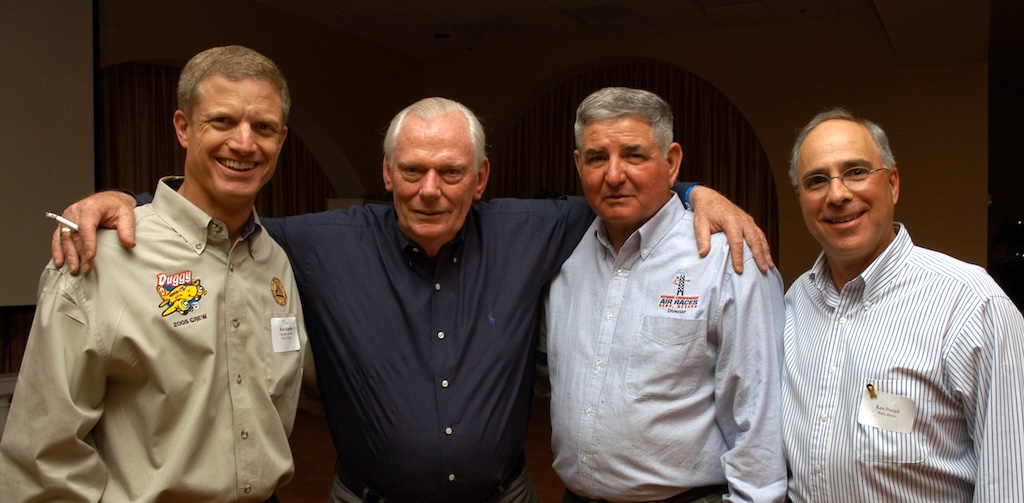
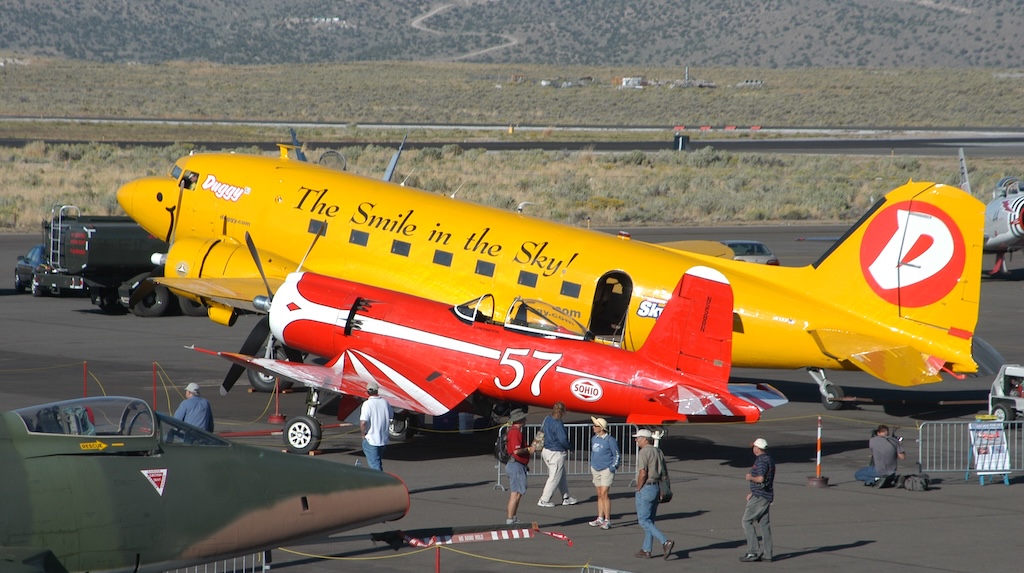
One memorable occasion was hosting Gene Cernan and the Mayor of Reno on board at their request for a briefing on the Duggy/SkyReach program and the crew’s cross-country tour. Yes, Cernan added his signature to Duggy’s now heralded bulkhead. Another treat was a late afternoon flight over Lake Tahoe for Invitational volunteers and partners’ guests like Steven F. Udvar-Hazy, who enthusiastically enjoyed some stick time in the right seat. It happens that in 1954, while a youngster in his homeland of Hungary, Hazy had taken his first airplane ride in an LI-2, a Russian-built copy of the DC-3.
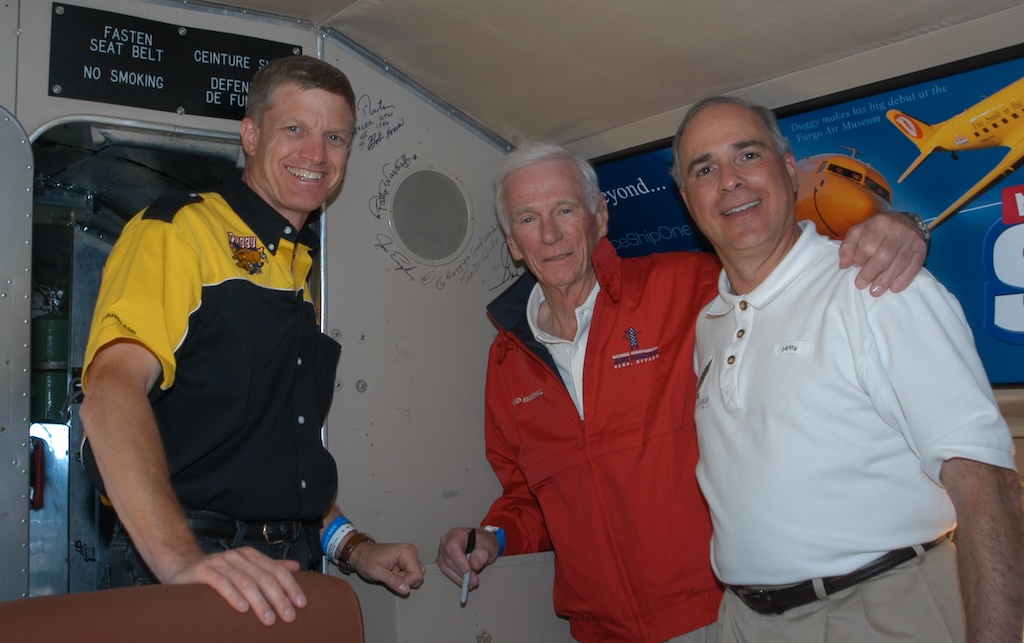
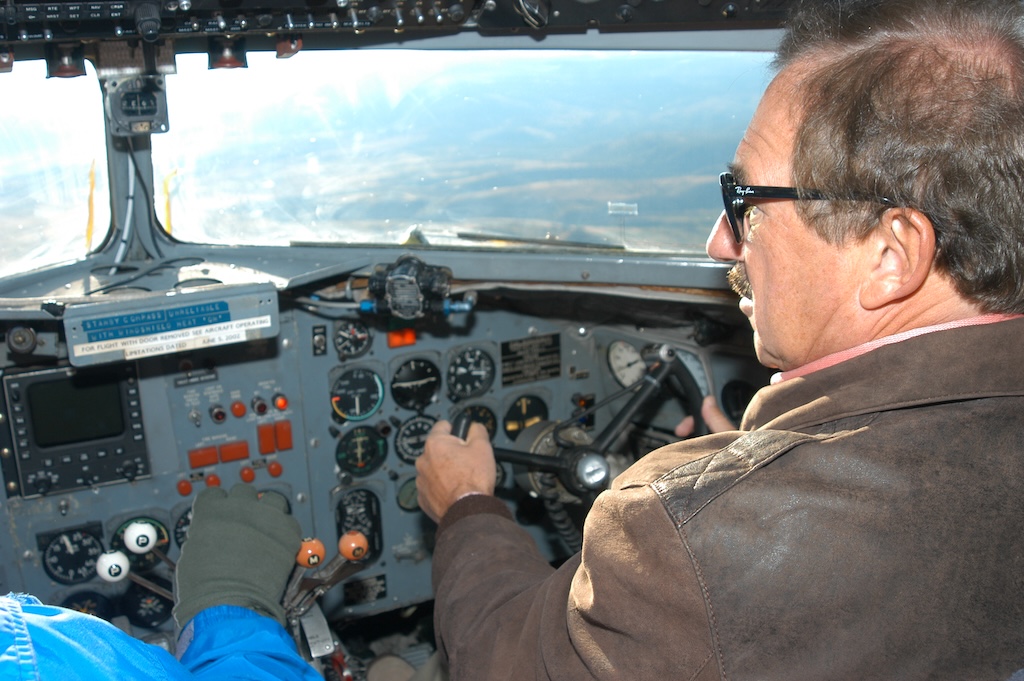
But another historic gathering taking place on board was certainly a first for Duggy, if not a second for two of the people involved. Among the many spectators the Darsts led through the cabin was an elementary school teacher from Chico, California, Sheri Eichar, attending with her former husband, Bob, and their two teen children, Ryan and Paige. Sheri and Bob were particularly enthused to learn of SkyReach and its focus on building self-esteem and character by utilizing the positive character traits of NAHF enshrinees. No one was aware that Sheri and Bob, both aviation and air racing enthusiasts, planned to re-wed and had decided that the Reno Air Races provided an ideal venue for their grand event. Soon after the Darsts’ toured them through, Betty was surprised when they asked if it would be OK to have their wedding aboard Duggy. Just to be safe, given this arguably extraordinary request, Jack sought Odie while Betty found Kaplan, seeking official approval before committing Duggy to serve as a wedding venue. Upon learning quickly that Odie gave his hearty approval, Kaplan asked Betty, “Where and when?” to which she replied, “Right here, and right now!”
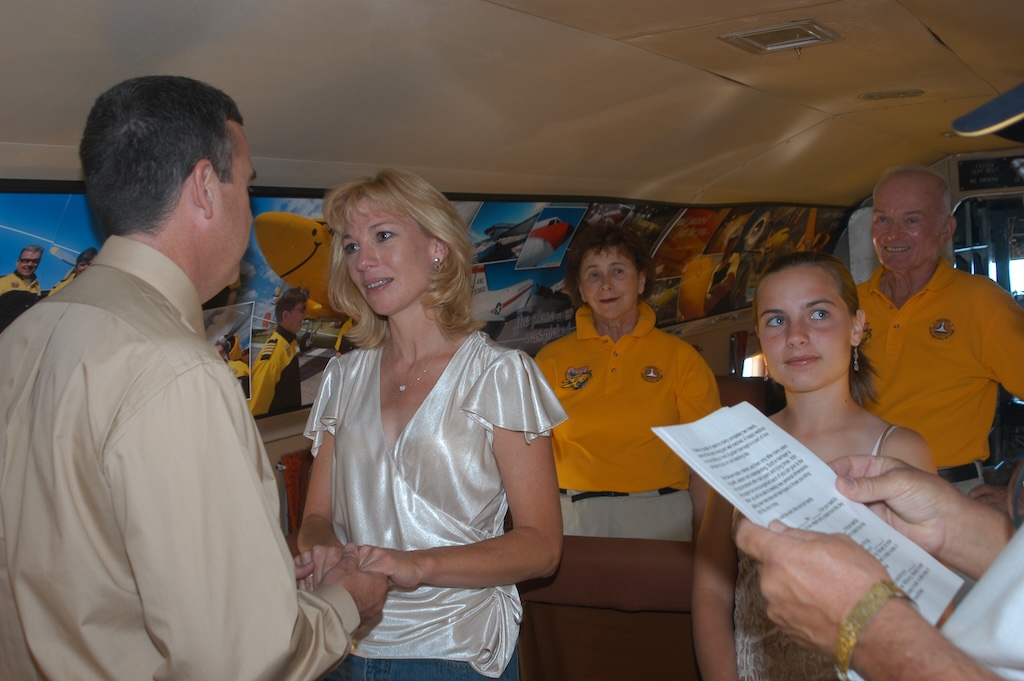
With the wedding party now gathered at Duggy’s steps, and Jack and Betty joining them to serve as witnesses, Alan Simpson, an air race volunteer who happens to be an ordained minister, and his wife, Pat, arrived from the flightline. When not helping VIP’s around the races each September, the Simpsons ran the “Arch of Reno Wedding Chapel.” Kaplan, seldom seen without a Nikon in his hand, was enlisted as their wedding photographer. Boarding Duggy, and now under the watchful eyes of Charles Lindbergh, Amelia Earhart, Donald Douglas and the many other enshrinees featured on the cabin’s educational panels, the Eichar’s were re-betrothed. Though no church bells were heard, the sweet sounds of a heat race overhead, mere yards from Duggy, were not an unwelcome substitute for the beaming newlyweds.
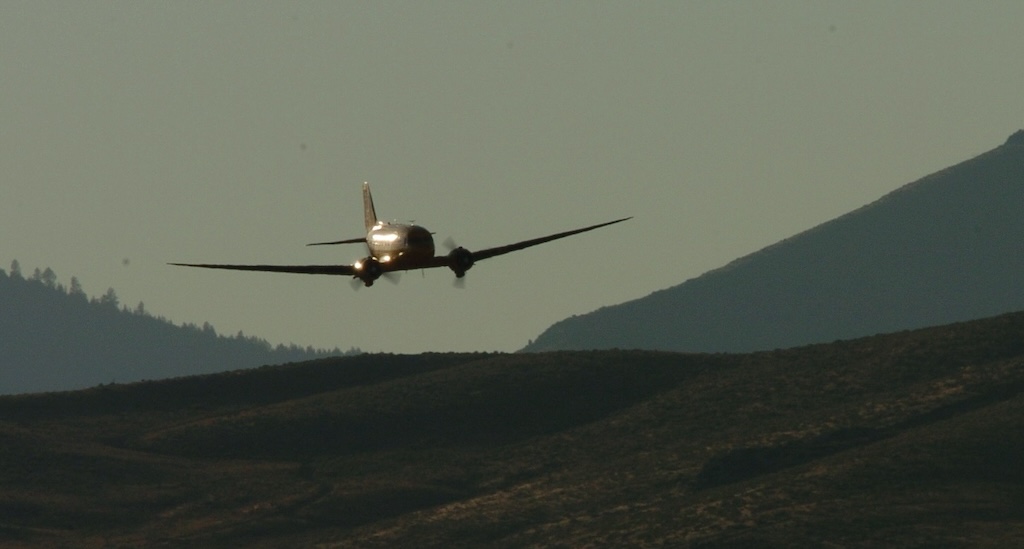
Though all that would seem hard to top, three months ahead would be the grand finale of Duggy’s inaugural SkyReach tour year, on December 17th – the 70th anniversary of the DC-3 on the very airport from which the type made its maiden flight in 1935, then called Clover Field. Kaplan and Trimborn have been coordinating the event for months. Trimborn led planning for the Douglas Plaza’s groundbreaking ceremony. On December 17th, one of his jobs would be to publicly unveil renderings depicting the Douglas memorial plaza, highlighting how Price’s DC-3 “Spirit of Santa Monica,” refurbished to be mounted on a pedestal, would serve as its striking centerpiece. Renting the massive Barker Hangar nearby for a post-ceremony reception and dance, Trimborn arranged for a swing band to perform from a stage next to the polished-up red-and-white DC-3.
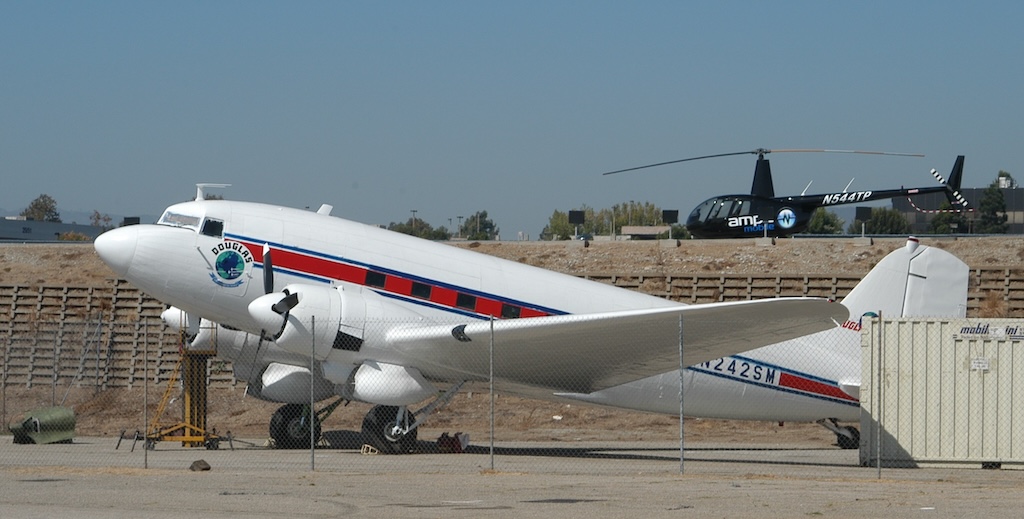
Meanwhile, from the NAHF side, Kaplan was working several complementary angles. One was of course to plan the on-site logistics for Odie’s Duggy crew. Fortuitously, a warbird operator and previous Invitational participant, Steve Craig, owned several U.S. hotel properties, one of which was in Los Angeles. As had so many others since Duggy first landed in Dayton earlier that year, upon Kaplan’s request, Craig generously responded, in his case providing rooms for the entire crew and Kaplan’s NAHF team of three, including photographer Mike Ullery. Though the Darsts could not make the trip, Kaplan accepted the offers of two Phoenix-based US Airways employees and a couple from Seattle who had seen Duggy at Oshkosh and offered to volunteer. Another angle was lining up special guests to lend a little “celebrity” to the anniversary events. Upon inviting a couple of locally based enshrinees, Bob Hoover and Buzz Aldrin, both accepted. The same for nominees Cliff Robertson and Clay Lacy (Cliff was inducted in 2006 and Clay in 2010). And adding special relevance to the milestone occasion and its VIP guest list were nine members of the Donald Douglas, Sr. family. Among them were his son, James Douglas, a grandson, and a granddaughter. But the biggest angle of all, despite a herculean effort by the whole Duggy team, did not pan out as hoped. For this historic milestone event, Kaplan had envisioned a massive formation flyover of DC-3s and C-47s for the plaza dedication, perhaps a dozen or more in the armada. With the help of Odie, well in advance of the anniversary, the request to other owner/operators went out, especially to those located west of the Mississippi. Kaplan worked with his industry contacts in the effort to get discounted, if not donated, fuel, food, and other deals to ease the costs of participating aircraft. Both the Million Air FBO and the AirTel Plaza Hotel at Van Nuys Airport stepped up with pledges of assistance and discounts.
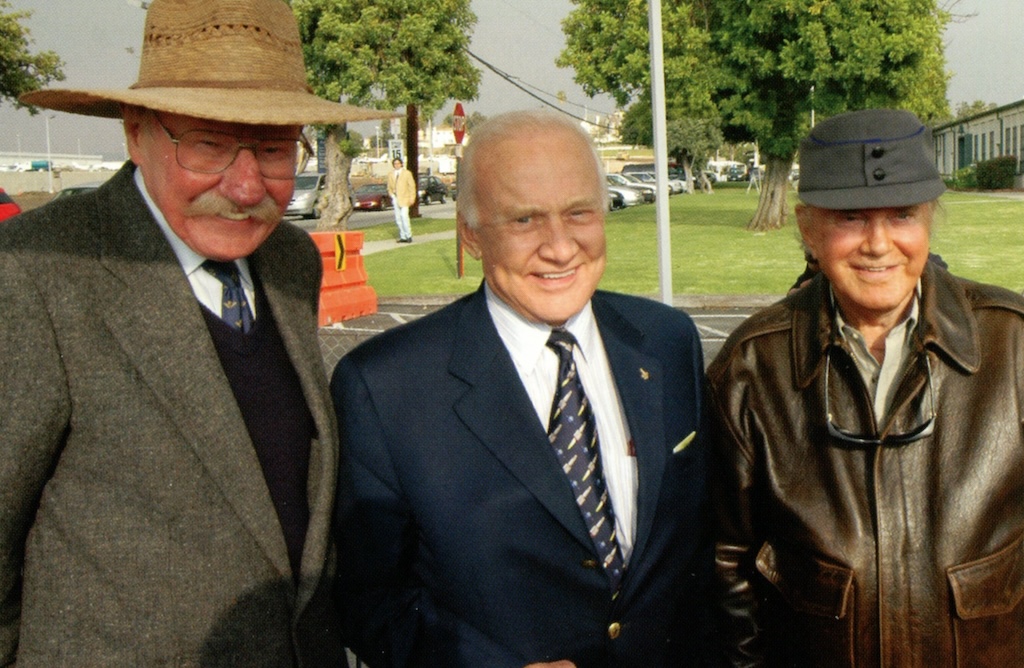
But though not entirely fruitless, Kaplan was disappointed with the response. As December 17th neared, one after another of a half dozen who had committed had to back out, usually citing the holiday timing, the soaring cost of avfuel, or mechanical issues. On the bright side, Lacy (15), who owned and flew a beautifully restored United Airlines DC-3 based at the Van Nuys headquarters of Clay Lacy Aviation, readily accepted Kaplan’s request to not only participate but to plan the flyover. That would prove a blessing, especially in the busy Los Angeles area airspace. Ultimately, it would be Duggy, Clay’s DC-3, and “Rose”, a DC-3 owned by Doug Pappas, that would form the trio overflying the event. December 17th at SMO proved to be another winter Southern California day. With the morning marine layer burned off, sunshine soaked the site of the groundbreaking ceremony. Duggy and the Rose had already departed SMO for Van Nuys, where Clay’s briefing was to overfly not only the memorial at SMO at the appointed moment, but five other area airports first. With over 50,000 flying hours in Clay’s logbook, the formation was in the best possible hands. With the NAHF enshrinees among other guests in his charge, Kaplan was resigned to stay with the hundreds gathering outside the Santa Monica Museum of Flying for the celebration. His morning had been spent jockeying Hoover and Robertson between local TV and radio news reporters covering the big event. Buzz called to say he was stuck in traffic but arrived just in time as Trimborn, along with Santa Monica’s mayor and other officials, got the ceremony started at 2 pm. Hoover, chosen to address the crowd as the NAHF’s representative, said that “Donald Douglas was the Henry Ford of the aviation transport business. We didn’t have much of an airline service until the DC-3 came along.”
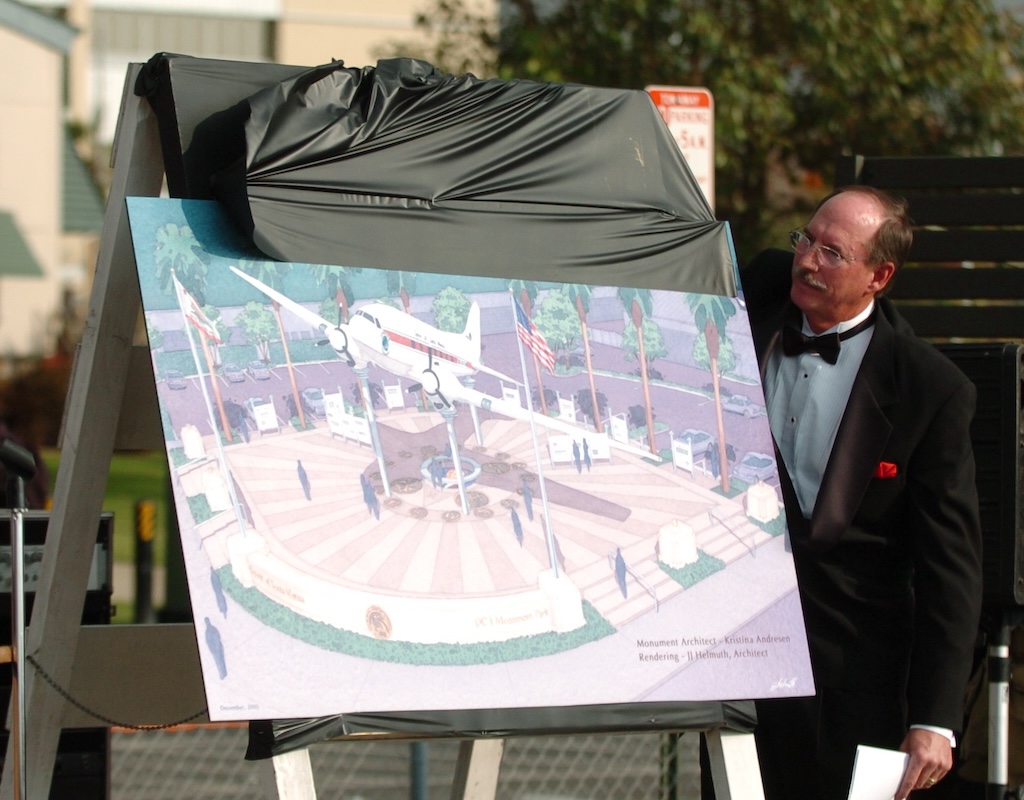
Just as Trimborn unveiled the large renderings showing what the completed monument to Douglas would look like and the official party did their ceremonial groundbreaking, the rumble of six big round Pratt & Whitney radials could be heard approaching. Arriving precisely on time, the formation of three dramatically passed over the crowd, at the very site from which the first DC-3 rose from the Douglas factory 70 years to the day prior. Many among the crowd, tearing up at the spectacle, were Douglas company veterans or their relatives. Kaplan beamed, knowing what fun Odie, Carley, and Duggy’s crew must be having in the air on such a memorable day. Clay had graciously let Duggy take the lead as the vic made its momentous pass.
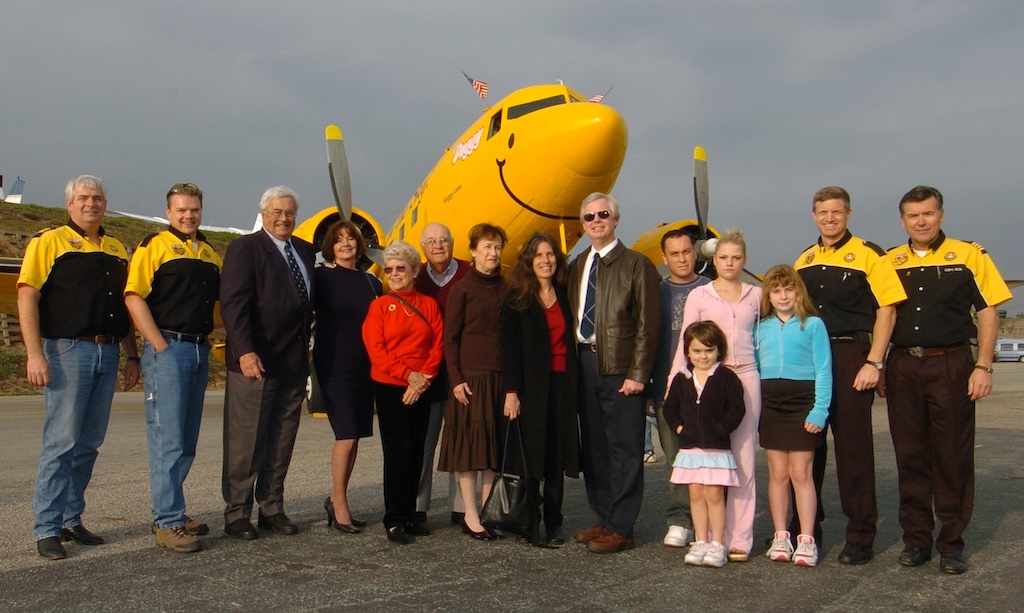
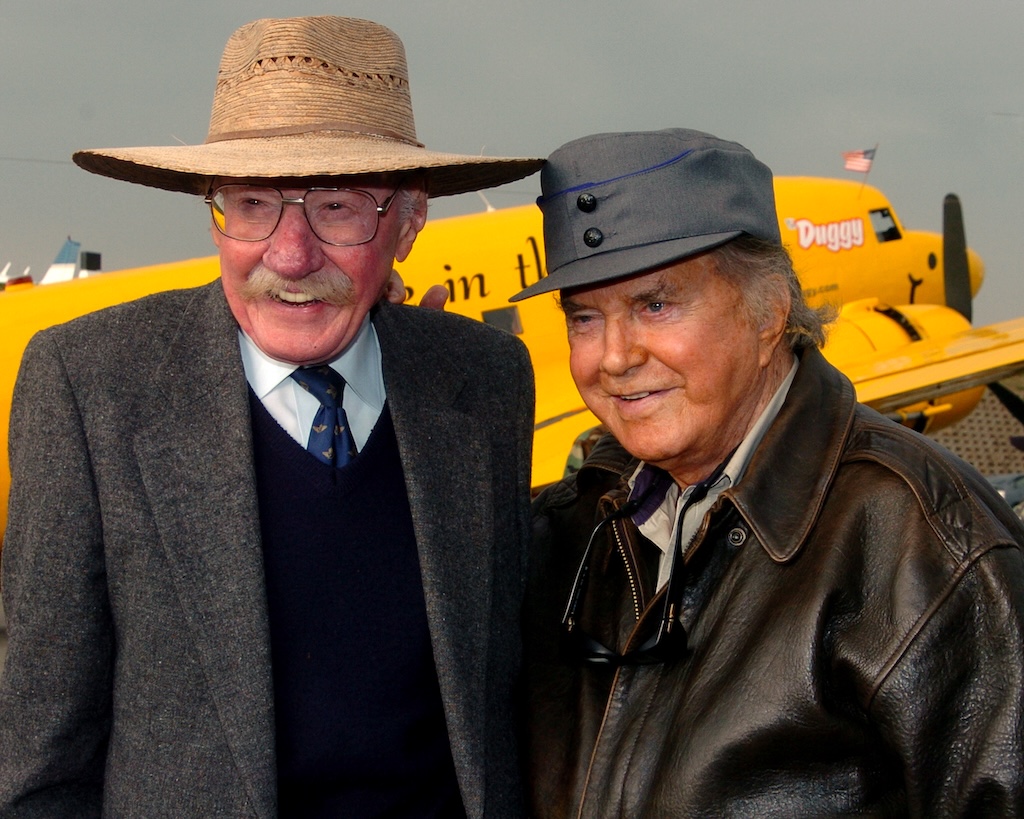
Once the aircraft recovered at SMO and taxied into place, Duggy was opened to the public for tours. The Douglas family was most appreciative to see the legacy of Donald Sr., so appropriately presented through Duggy’s SkyReach displays in the cabin. With the crew and NAHF volunteers busy on the ramp, Kaplan and his staff set up a NAHF display in the Barker Hangar as the band warmed up. Upon seeing Clay taxi his DC-3 near the open hangar and shut down for the evening, Kaplan rushed out to heartily thank him for his multiple roles in making the flyover a success.
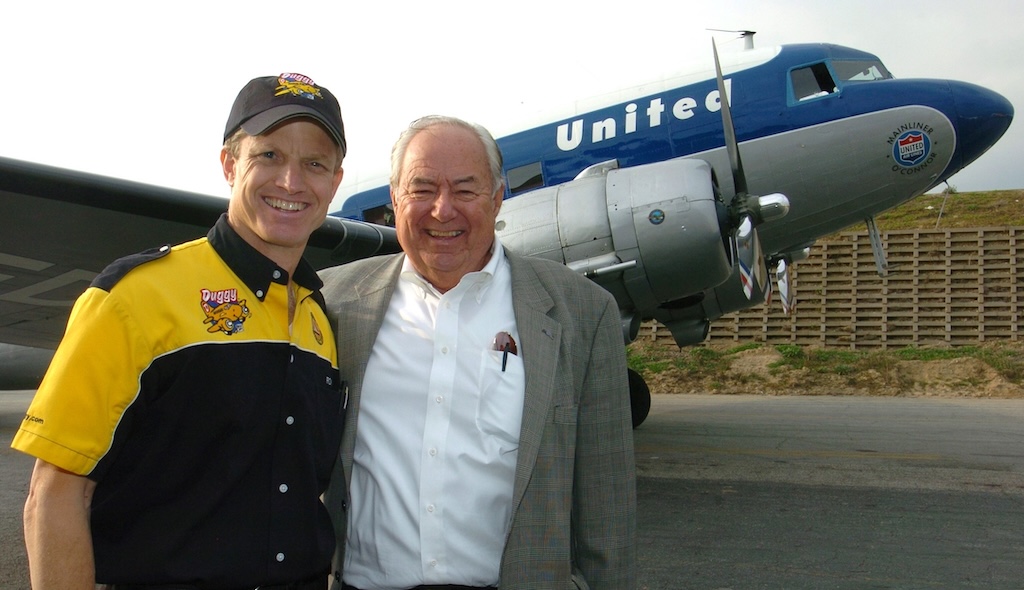
Proceeds from the hangar party, including a raffle for a twilight flight on the “Rose,” went toward the support of the plaza’s construction. Fueled by the excitement of the special day, Kaplan exchanged thoughts with Trimborn and Price about staging an even bigger celebration for the 75th anniversary of the DC-3 in 2010. The crews enjoyed dinner and beverages to the tunes of Glenn Miller. And though he and Carley were each relieved and gratified at the parts they played, not only in the DC-3 anniversary party going on around them, but the whole year of Duggy’s SkyReach tour, they knew it was time for significant decisions to be made. The very next morning, Odie, his family, Challans, Carley, and Kaplan gathered in their hotel conference room. Before they got into the fiscal realities of their respective situations, Kaplan, noting an uncharacteristic somber tone, first had a positive prospect to share with the crew. During the 2003 Centennial of Flight celebration in Dayton, he had been introduced to Brazilian pilot and businessman, Fernando Bothelo. Bothelo was a fan, he explained, who had eagerly been following news of Duggy’s travels since seeing it at the Dayton Air Show. Bothelo, through the NAHF, had just recently extended an invitation to the crew to bring Duggy and SkyReach down to South America on a tour that would conclude with an appearance at his Sao Paulo air show in May 2006. He even pledged Brazilian sponsorship for most, if not all, of the tour costs. The response was tepid, at best, but not all that surprising to Kaplan. His SkyReach grant was depleted, and he was well aware of Odie’s investment since committing Duggy to the paint shop a year earlier had also been significant, not only in money but in man-hours. All were aware that, despite Kaplan’s best efforts, nearly everyone loved Duggy, but no North American corporation or donor would step up with even a co-sponsorship to support operations.
It so happened that, post 9/11 in America, Kaplan learned that even those businesses intimately involved in commercial and general aviation wanted the liability that came with having their logo on an aircraft, much less on that of a 70-year-old type. In other words, lawyers won and SkyReach lost. Odie thanked the NAHF but told Kaplan that Duggy would next be off to other vistas, possibly even a feature movie project of Carley’s. Kaplan was crestfallen but understood the reality of the situation. His receipt of an email from Challans dated January 1, 2006, officially confirming the termination of the Duggy/NAHF partnership only stung again. Kaplan immediately took necessary steps to ensure SkyReach continued, sans a flying DC-3. Soon, SkyReach materials were reprinted to feature Hank Caruso’s cartoon aircraft art. They replaced the Duggy and Friends characters, to which Carley retained the rights. 2006 would seem strangely quiet, what with not having to rally resources around a DC-3 tour. The NAHF Learning Center, however, would still bustle with its couple of hundred thousand visitors a year coming through its doors, hosting the annual “Oscar Night of Aviation,” and having a presence at annual events like AirVenture, the NBAA Convention, and as always the Invitational at the Reno Air Races.
Duggy, in turn, had its SkyReach and NAHF markings replaced with generic Duggy branding. Based out of the Fargo Air Museum, Odie and his crew continued to take Duggy to various airshows and appearances at AirVenture. And indeed, after filming largely at Stead Field in Reno in 2008, the movie Carley wrote and directed, “Thunder Over Reno,” was released. Filmed at Stead Field, it featured a host of warbirds, including Duggy, Race #57, and others, along with crew appearing in various roles. With that creative itch scratched, Carley continued his career in corporate marketing while continuing to develop the Duggy and Friends brand online and through other media.
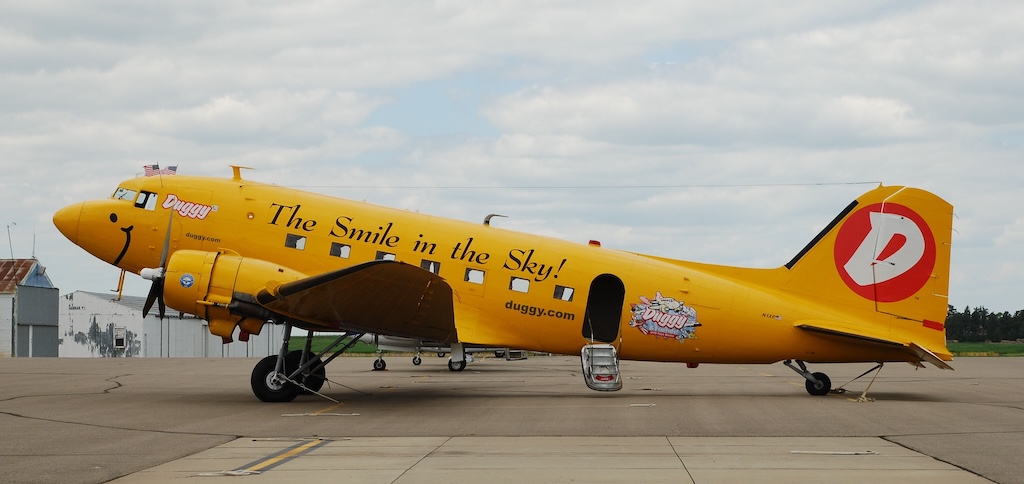
Sadly, in September 2012, while practicing for an air show, Bob Odegaard was killed in the crash of another of his two Super Corsairs. (17a) He was 66. Having been a mentor to so many in the aviation community, his lengthy obituary said this, “Perhaps his dedication to the future of aviation is best illustrated by Duggy, a DC-3 painted bright yellow with a smiling face. Duggy excites young people at air shows around the country.” None of that excitement would have happened without Odegaard sharing Carley’s and Kaplan’s ambitious vision of a flying Duggy and of SkyReach, and making the pairing of them possible to share with thousands of others.
A recent post on Facebook anecdotally illustrates the remarkable impact that Duggy and SkyReach made on young people during that magical 2005 tour year, and it also serves as testimony to the enduring influence of the DC-3. Tim Savage – an experienced pilot and owner of a DC-3 among several other warbirds – earlier this month posted this along with a 2005 photo of his then very young son, Job: “Job and I are back from Sun ‘N Fun, and he is off on his next aviation adventure. It dawned on me this morning that it was 20 years ago that we took the B-25 to Lakeland. That was the year Ron Kaplan and Mitch Carley brought the DC-3 ‘Duggy’ to Sun ‘N Fun. Job adorned the windows of our rental car with Duggy stickers. For a few years, he called DC-3s ‘Duggies.’ Hard to believe he is all grown up now and flying ‘Duggies.’ While Sun ‘N Fun has changed, the memories and photos remain.”
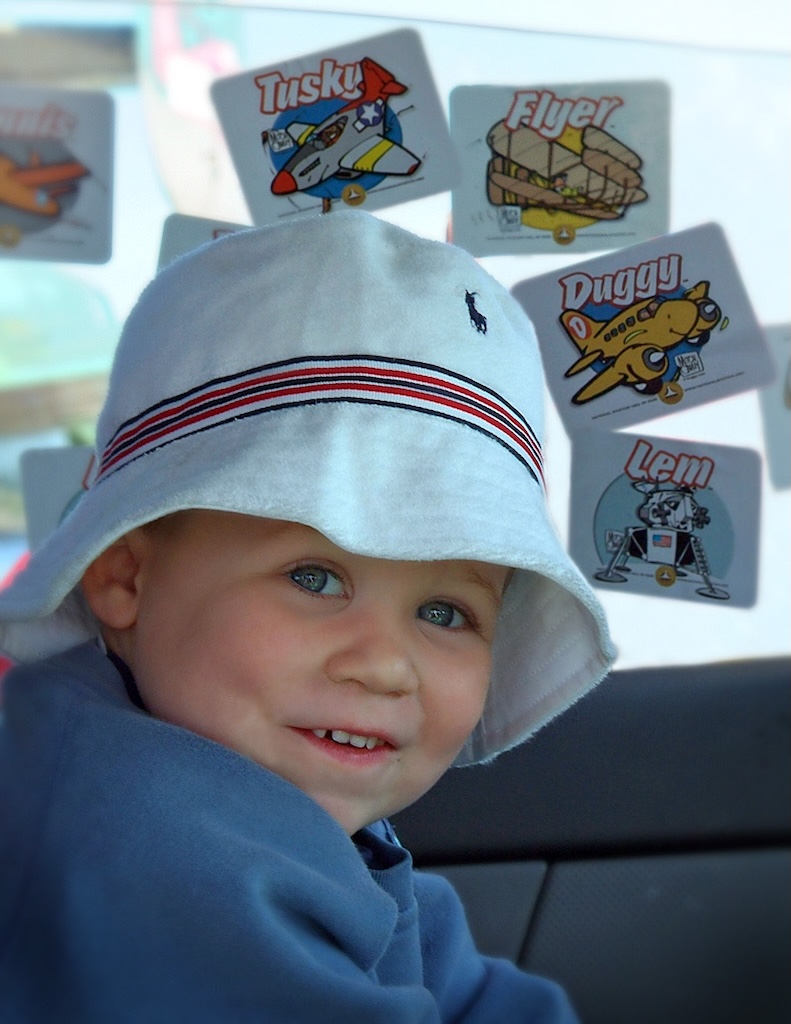
Seems a very fitting tribute to Carley, Kaplan, Odegaard, Thompson, the NAHF, and many others responsible for bringing ‘Duggy the DC-3’ and SkyReach to the skies, first 20 years ago this month, and enabling its magical coast-to-coast 2005 tour. (18) As we look forward to the 90th anniversary of the DC-3 this December 17, 2025, perhaps we’ll again see and hear the big yellow “Smile in the Sky” rumbling overhead to mark the historic milestone in fitting style that would make Donald Douglas, Sr., and Captain Bob beam.
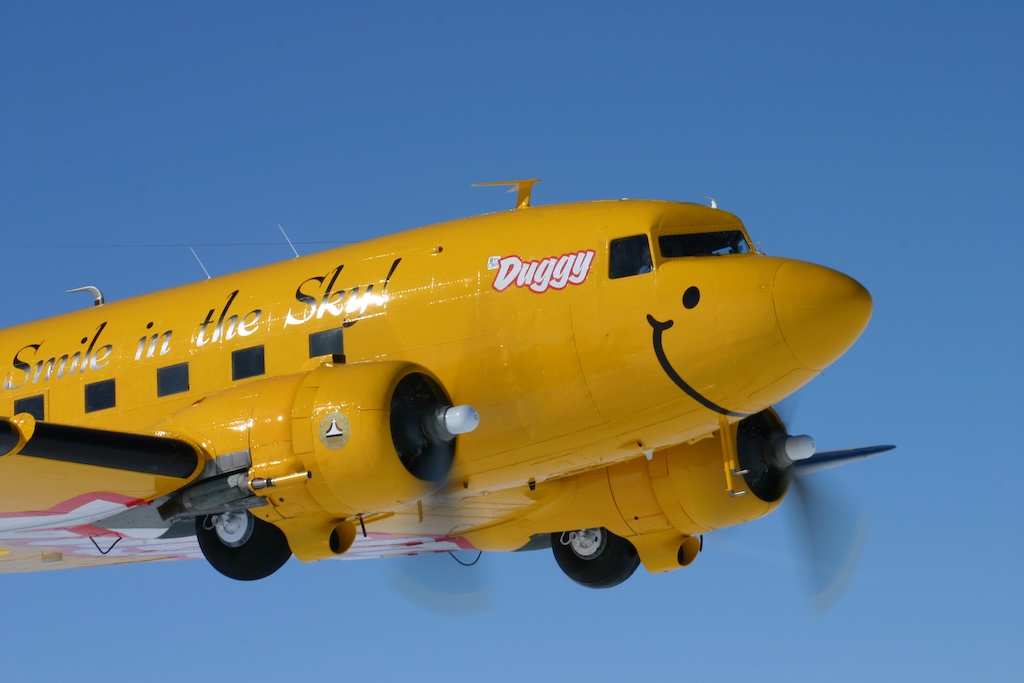
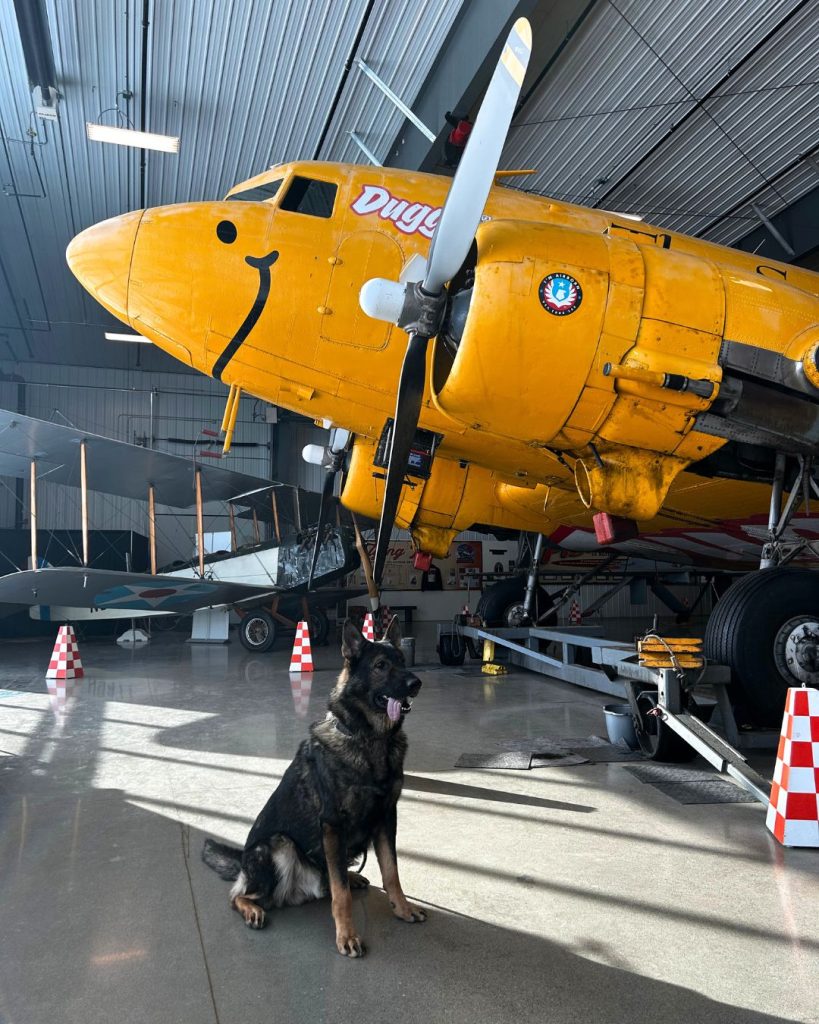
The writer acknowledges the assistance of Ron Kaplan, Mitch Carley, and NAHF photographer Mike Ullery with this story. Thanks, Tim and Job Savage, for the use of their post. Photos are credited where possible.


